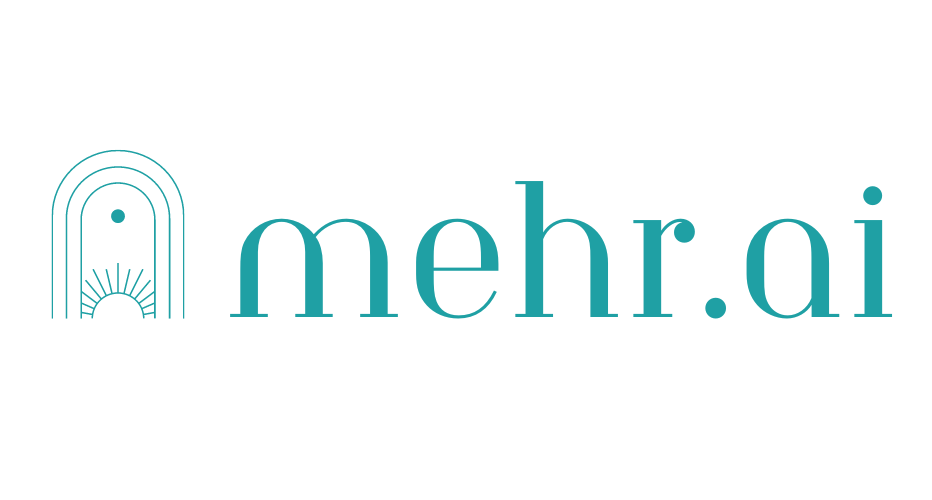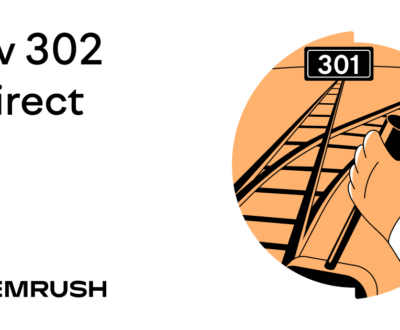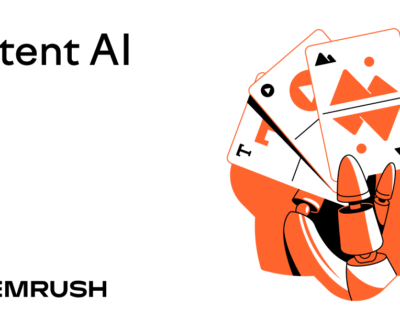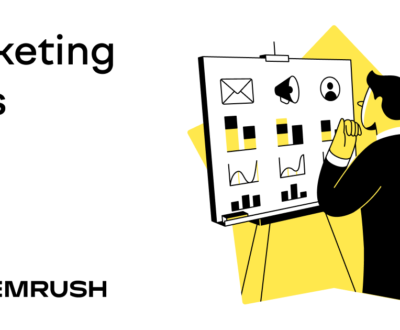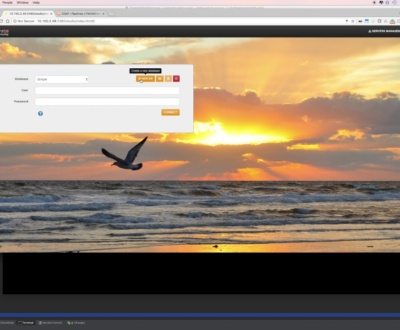[ad_1]
Google Analytics 4 (GA4) is a free internet analytics platform that permits you to measure your web site’s site visitors and engagement. However many processes and capabilities have modified since Common Analytics (UA).
GA4 is now “event-based.” It captures every consumer interplay along with your web site as a single occasion. Google Analytics makes use of these occasions as the premise for versatile reporting. That can assist you extra precisely predict consumer conduct.
On this article, we’ll cowl seven superior Google Analytics ideas. The following tips will show you how to analyze your web site’s information extra effectively.
1. Import Your Uncooked Knowledge Into Google’s Warehouse
Arrange Google BigQuery, Google’s totally managed information warehouse resolution and import your occasion information from GA4 into it. The instrument’s highly effective information storage and querying capabilities imply you are able to do extra in-depth evaluation.
Deeper evaluation will show you how to acquire deeper insights into consumer conduct, determine traits and patterns, and make extra knowledgeable advertising and marketing choices.
Listed here are a few of the issues you are able to do with BigQuery that you could’t with GA4 alone:
- Retailer and analyze uncooked information. GA4 experiences are topic to sampling, which means they use a subset of the uncooked information to determine patterns and traits. BigQuery shops and analyzes all of the information you import to create experiences. Utilizing laborious numbers as a substitute of patterns provides you extra correct outputs.
- Do in-depth information evaluation. BigQuery’s versatile and broadly used normal SQL (structured question language) enables you to do extra complicated information evaluation in your GA4 information. You’ll be able to question your database simply with plain English phrases like “Choose” and “Common.” So you may carry out capabilities like evaluating common values rapidly and effectively.
- Mix information with different sources. BigQuery can import information from exterior sources, like CRM methods or advertising and marketing automation platforms. Combining your GA4 information with information from different sources provides you a extra complete view of your prospects and advertising and marketing efforts.
To get a really feel for the way it works, you may hook up with BigQuery immediately from GA4. (You’ll be able to arrange a billable account inside the Google Cloud free tier or use the BigQuery sandbox setting without cost.)
Right here’s how.
Out of your GA4 house web page, click on “Admin” and choose “BigQuery Hyperlinks.”
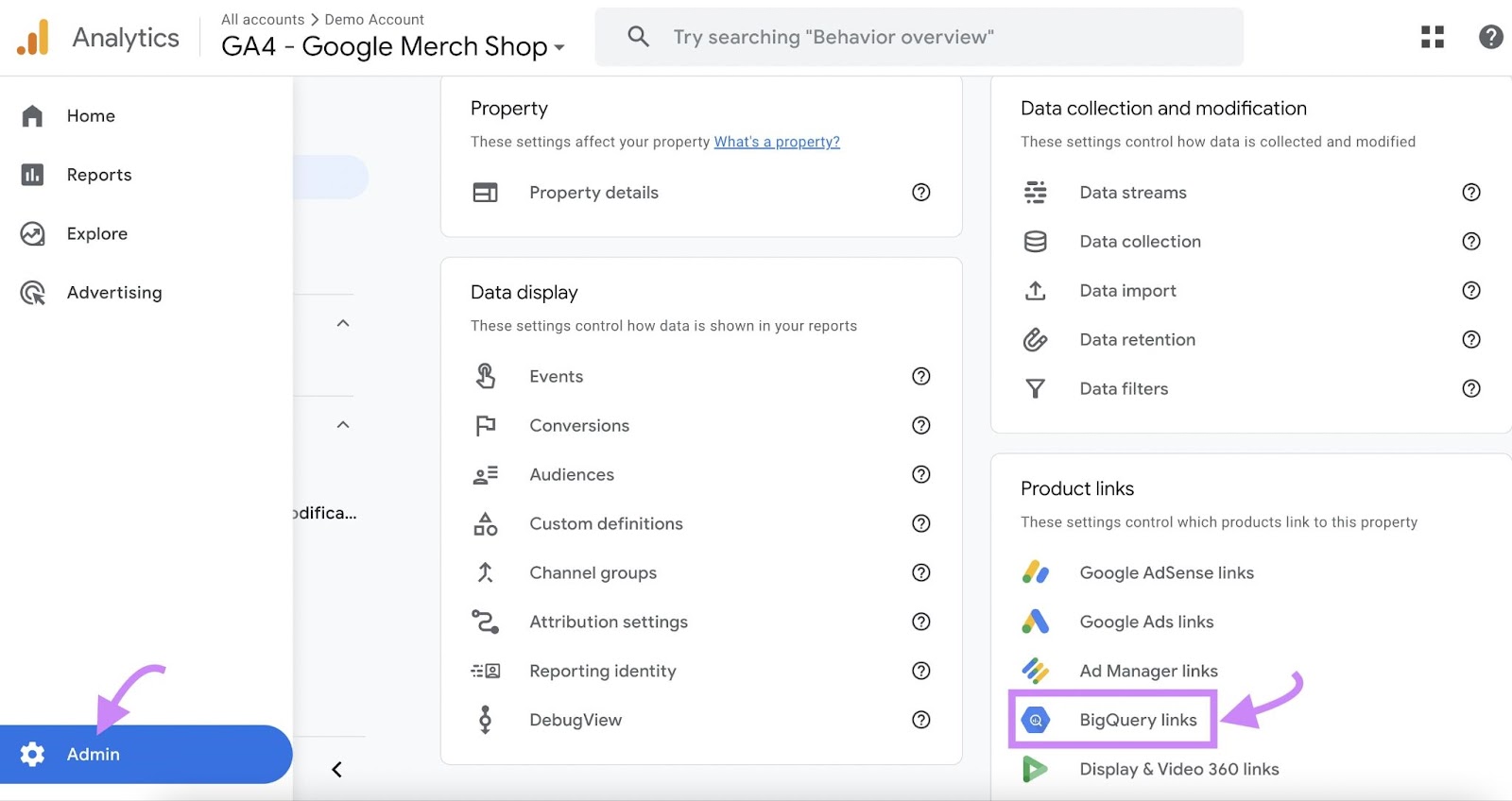
You’ll must create a brand new connection. Click on “Hyperlink” to take action.
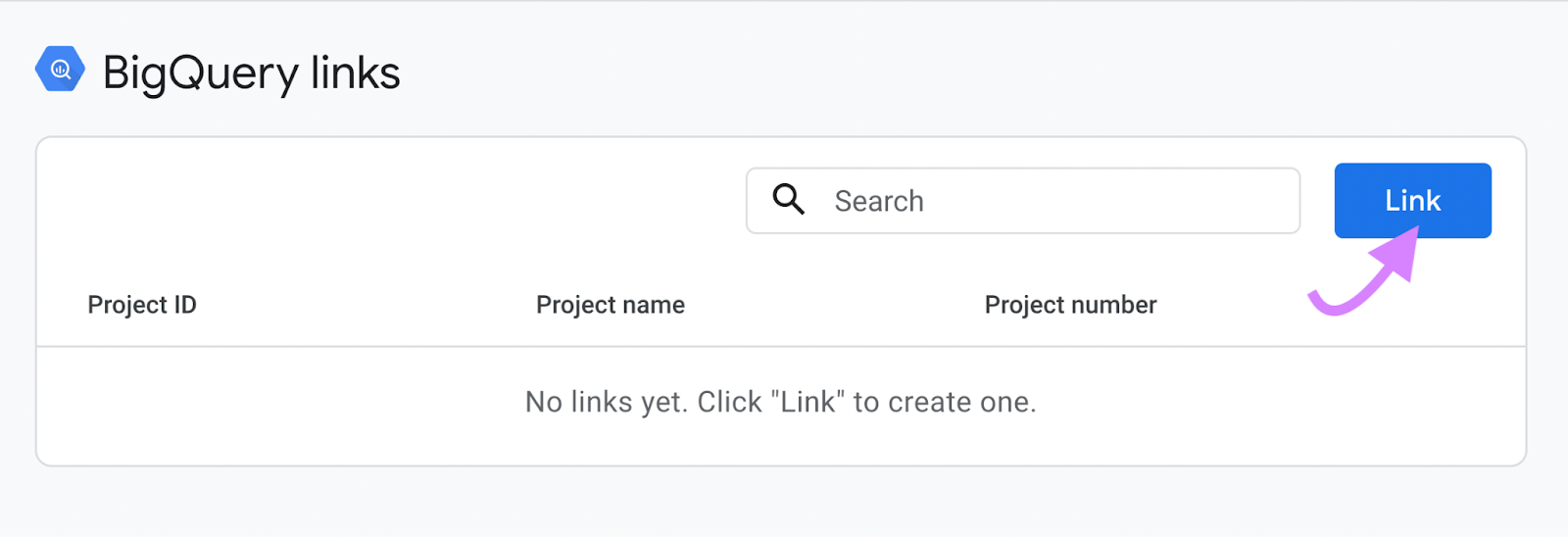
Click on “Select a BigQuery mission.”
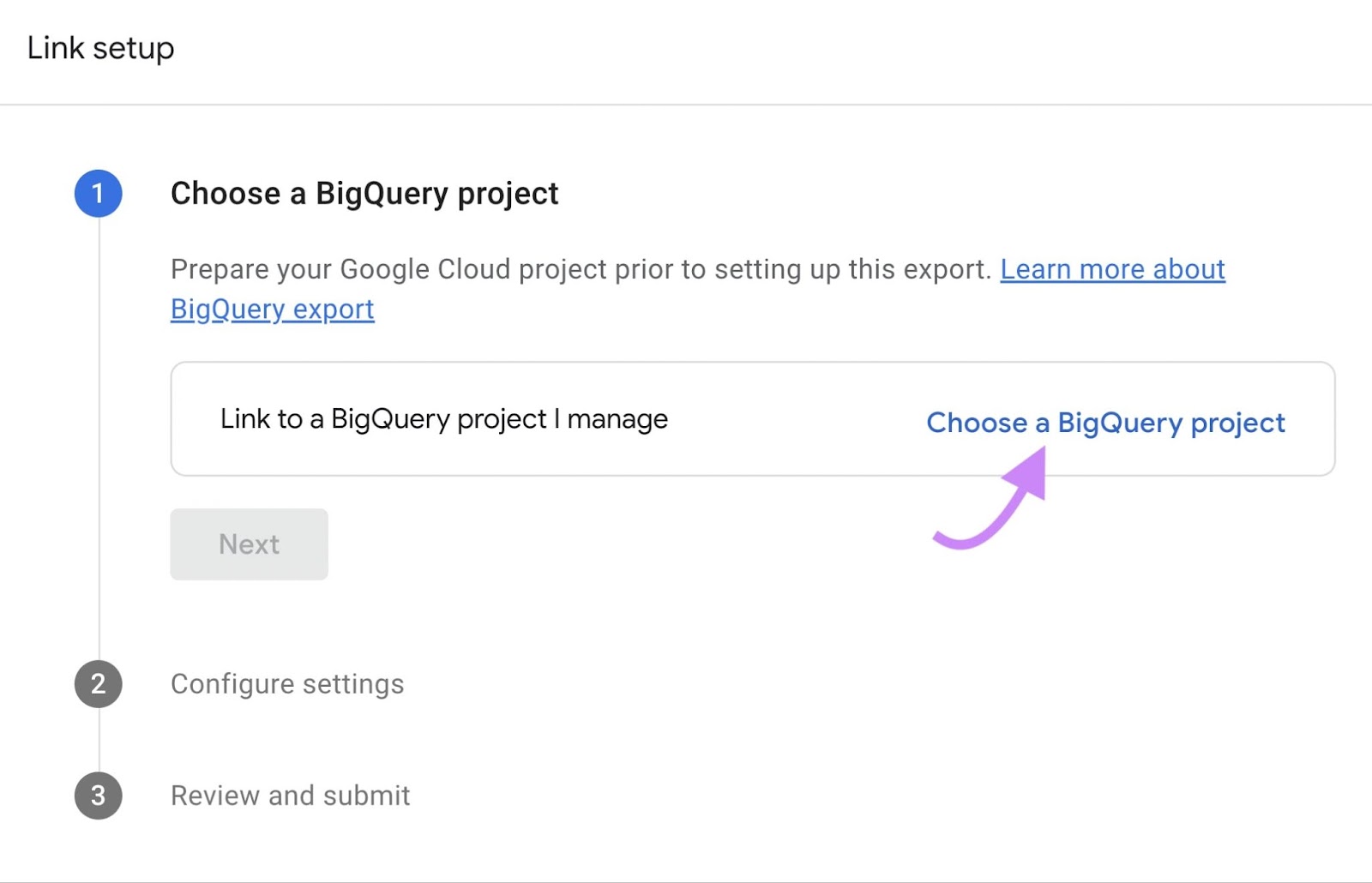
Verify the field subsequent to your present Google Cloud mission. Then click on “Affirm.”

Choose your area from the dropdown menu and click on “Subsequent.”

Determine how typically you wish to run the information export.
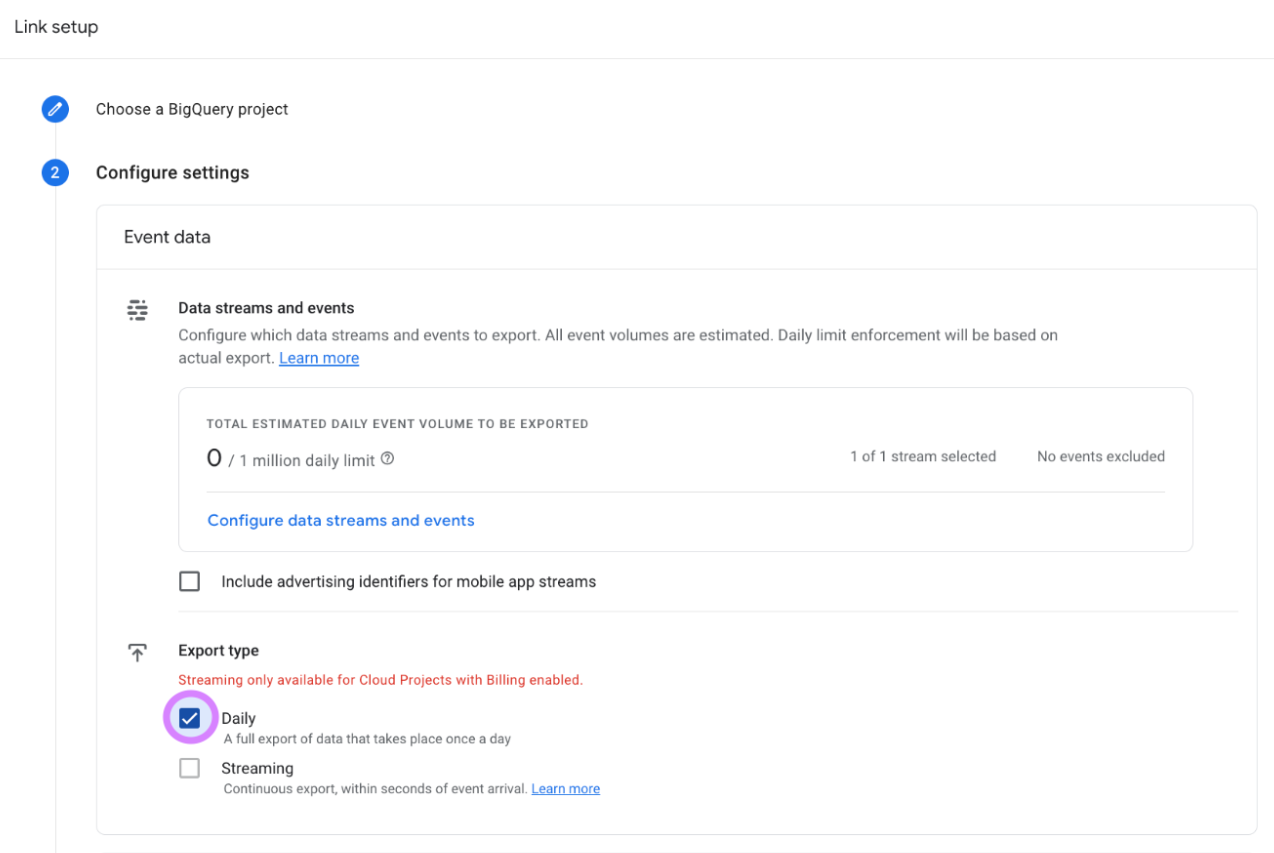
While you’re completed, click on “Subsequent” to evaluate your settings. If all the pieces appears to be like proper, click on “Submit.”
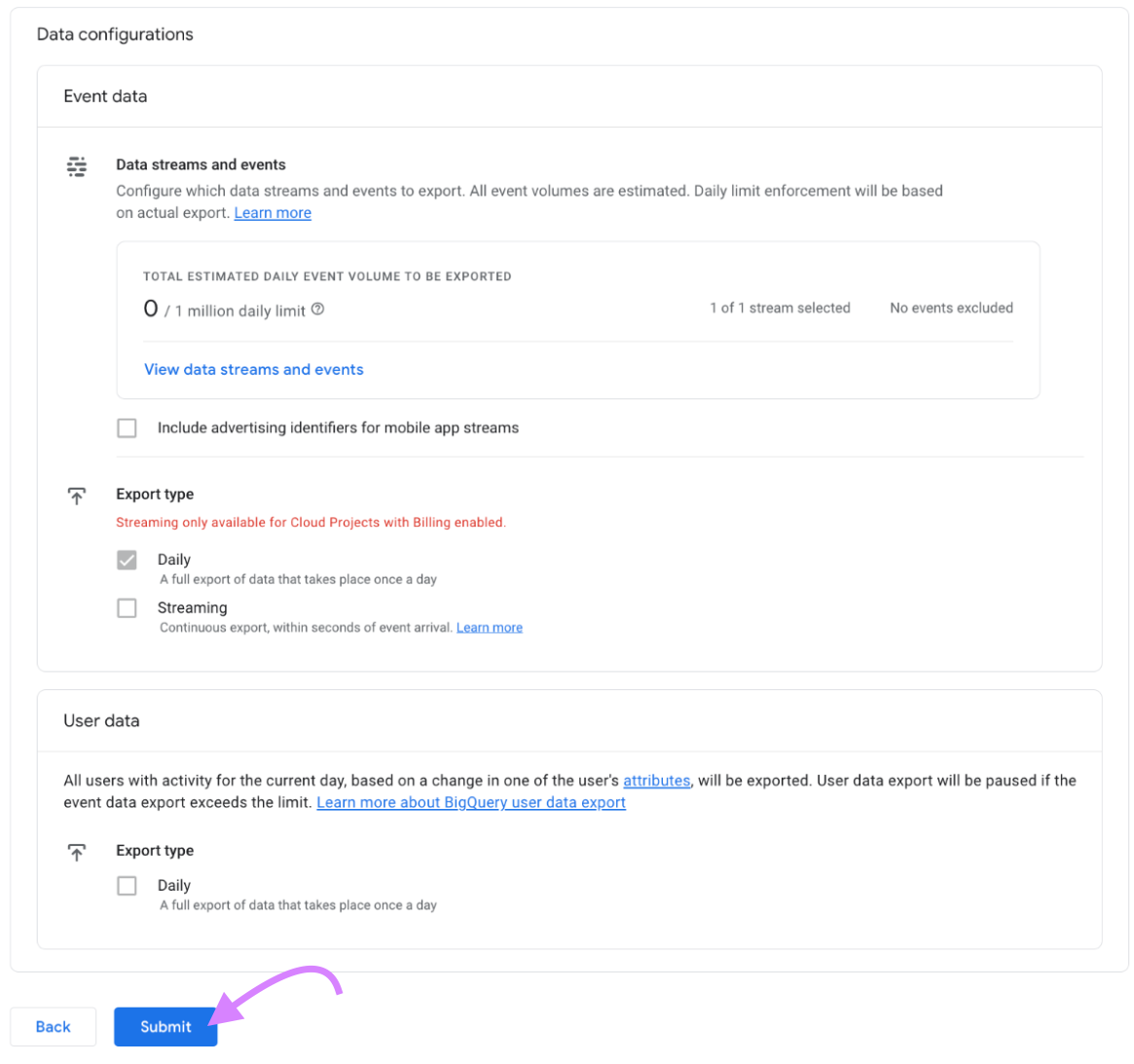
Your BigQuery hyperlink has been created!
You’ll want to attend (as much as 24 hours) on your information to point out up in BigQuery.

As soon as you may see the information, you can begin to question the information tables. (You’ll be able to find out about tips on how to run queries in BigQuery in this information.)
The next Google traits demo question provides you an thought of what you’ll see in an actual question:
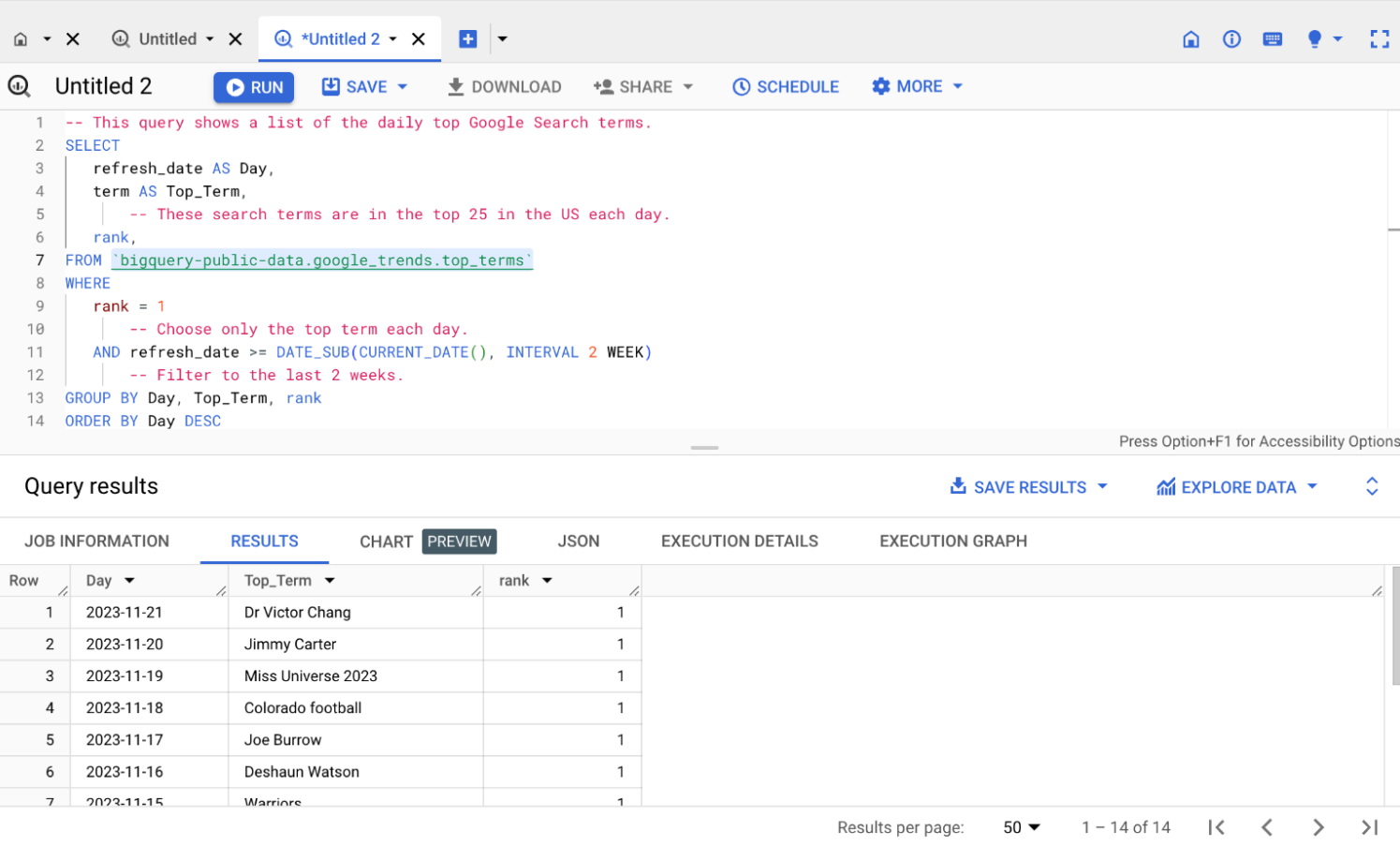
2. Register Your Occasion Parameters as Customized Definitions
GA4’s occasion monitoring works in a different way from the hit monitoring of Common Analytics. Whereas it tracks some metrics robotically, you’ll must arrange others as customized definitions for higher evaluation.
GA4 captures any interplay (beforehand a “hit”) as an “occasion.” An occasion may be something from somebody clicking a hyperlink to creating a purchase order.
Setting “occasion parameters” enables you to accumulate extra details about an occasion.
For instance: When somebody indicators up for a publication (the occasion), it’s possible you’ll wish to know which type they used (the parameter).
On this case, you’d use the “form_id” parameter. To take action, you’ll must register it as a “customized definition” in GA4.
However first, there are two kinds of customized definitions:
- Customized dimensions describe what customers work together with in phrases (e.g., class or coloration)
- Customized metrics describe what customers work together with in numbers (e.g., worth or amount)
Let’s use the above publication signup type instance to arrange an occasion parameter as a customized definition.
Head to GA4 and click on “Admin.”
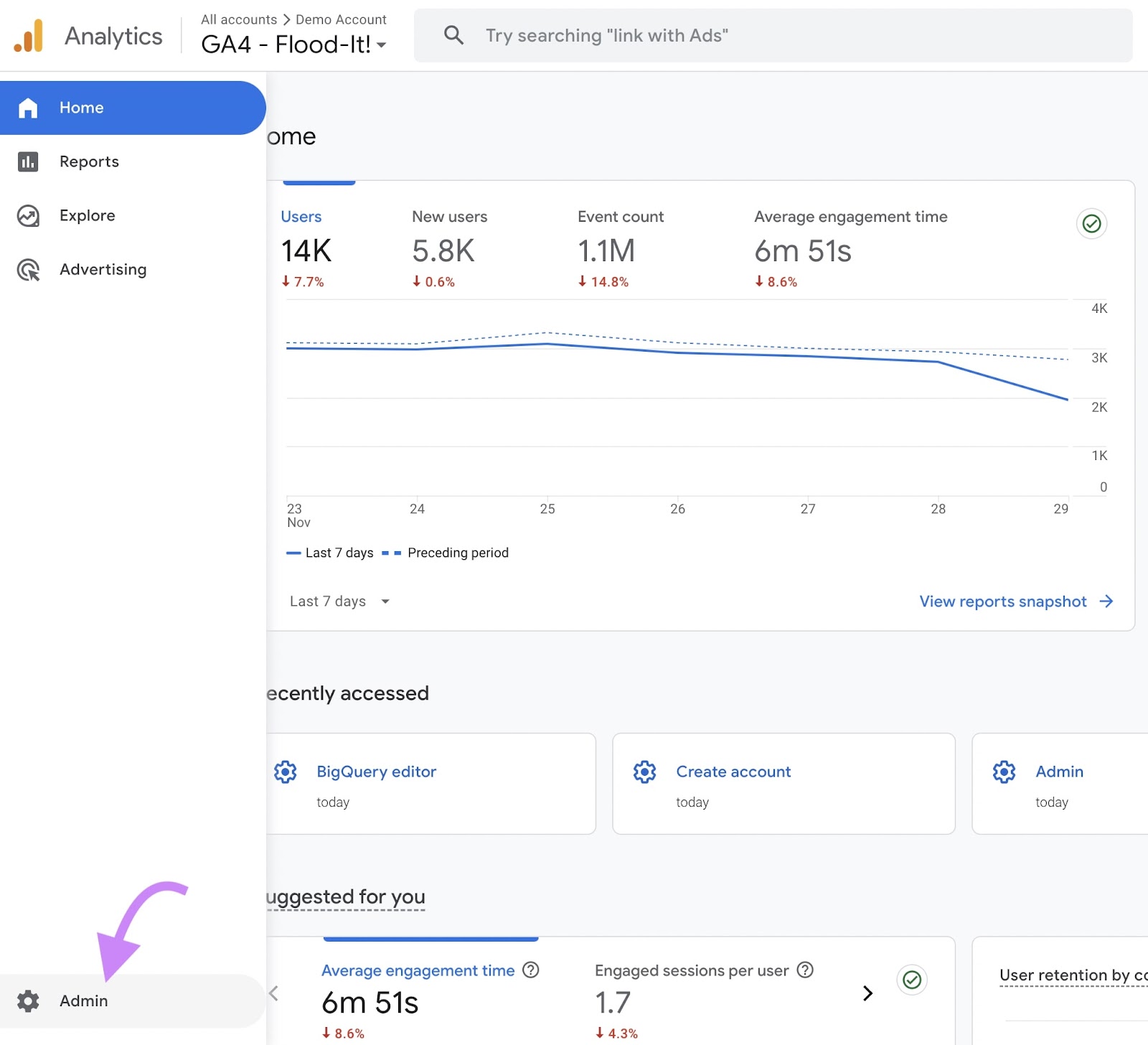
Then click on “Customized definitions.”
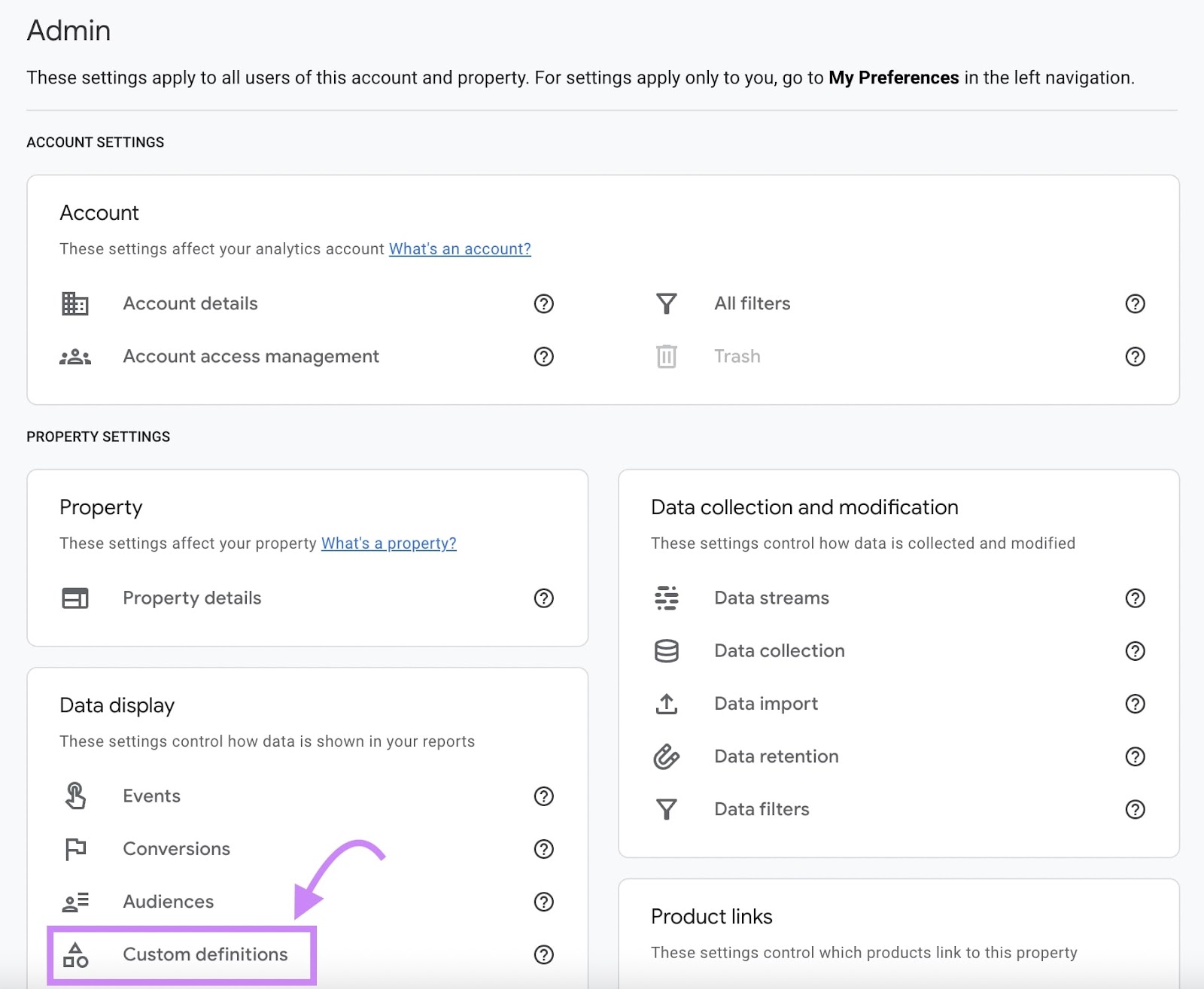
On the following display screen, choose “Create customized dimensions.”

Then select a reputation on your dimension (e.g., “Kind ID”). And ensure the Scope says “Occasion.”
Write an outline (e.g., “ID for signup kinds”) and choose the occasion parameter (e.g., “form_id”).
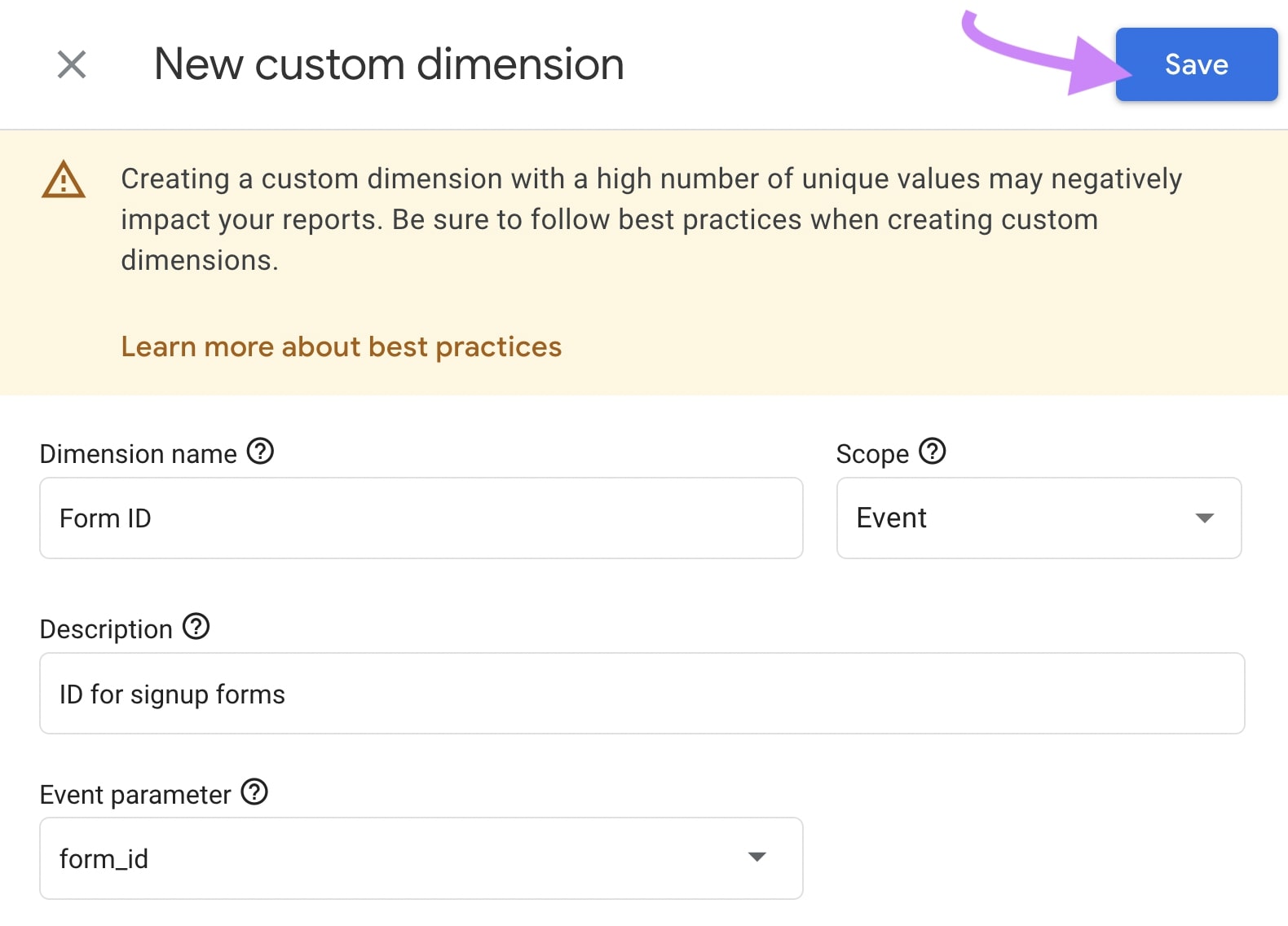
Then click on “Save.”
3. Guarantee Knowledge Privateness with Google Tag Supervisor
Google tags are segments of code that show you how to measure the efficiency of your web site and adverts. Use Google Tag Supervisor’s consent mode to ask customers in case you can retailer particulars about their go to.
This characteristic helps you adjust to GDPR laws and robotically alter tags to adjust to customers’ consent selections.
You’ll be able to request information consent by way of a third-party consent administration platform. Or you may construct a web site banner like this:

Both method, you may management consent settings for GA4 inside Google Tag Supervisor (GTM). Right here’s tips on how to arrange consent mode in GA4:
Head to GTM and click on the “Admin” tab.
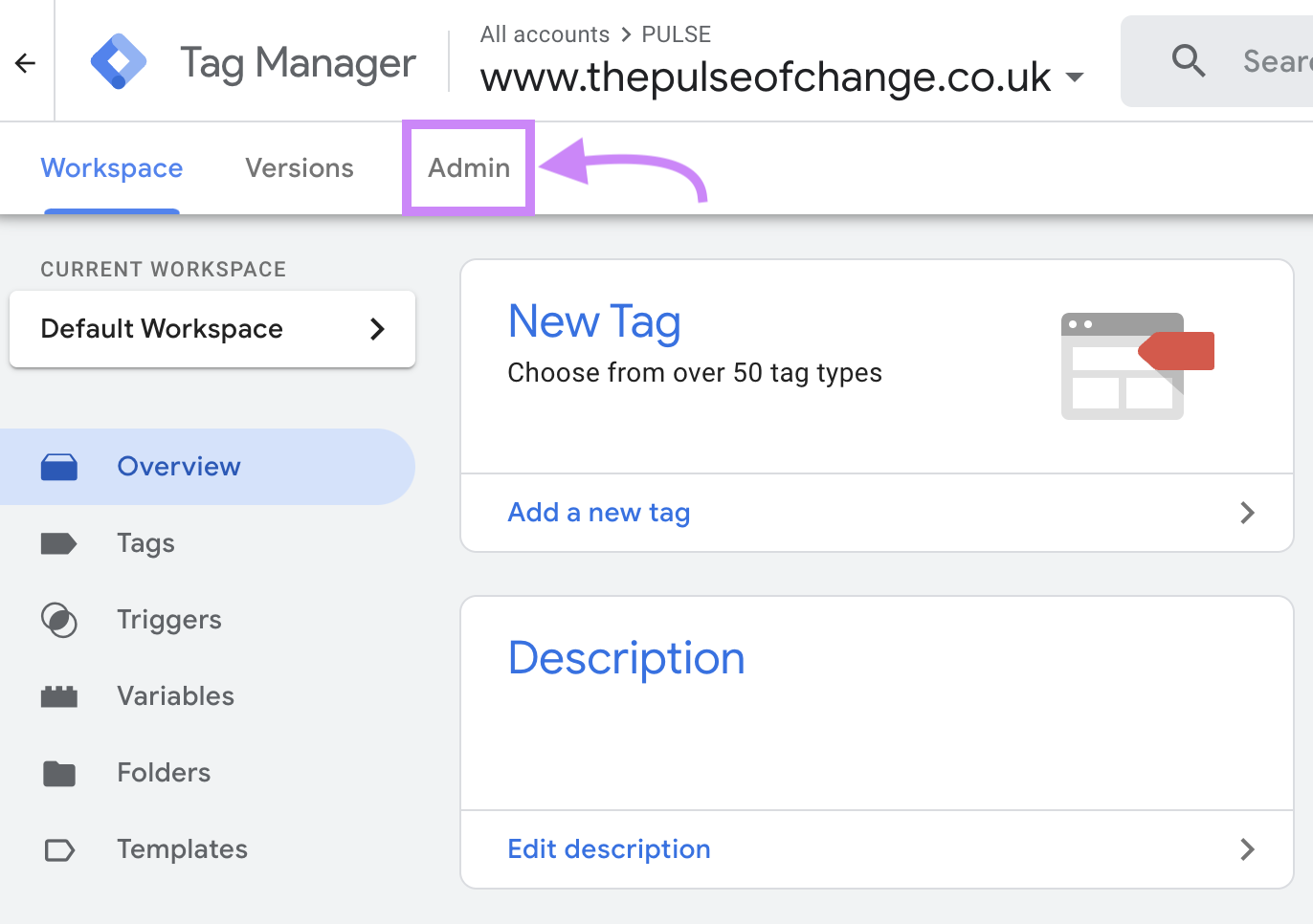
Within the following window, click on “Container Settings.”
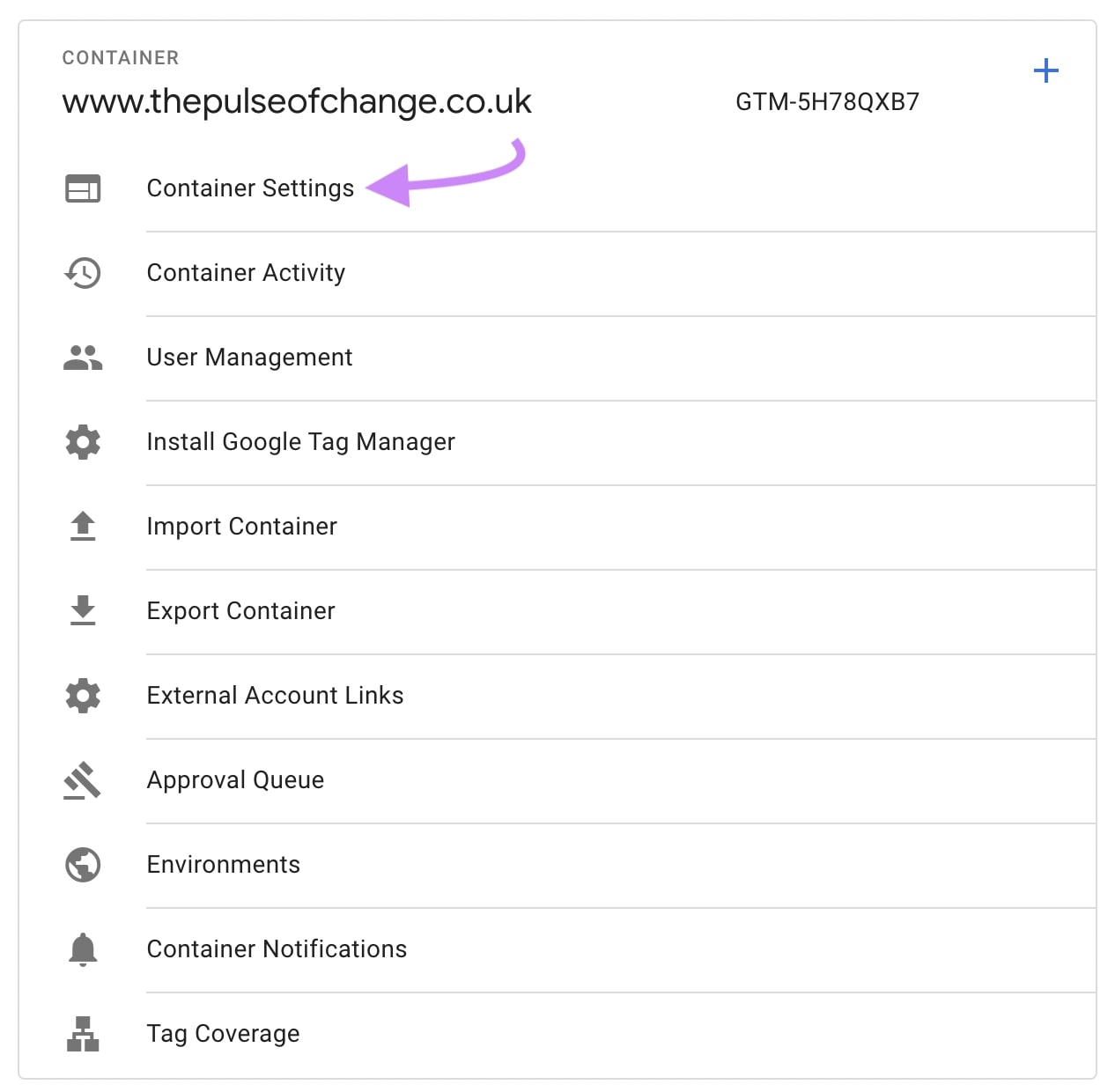
Then verify the “Allow consent overview” field and click on “Save.”
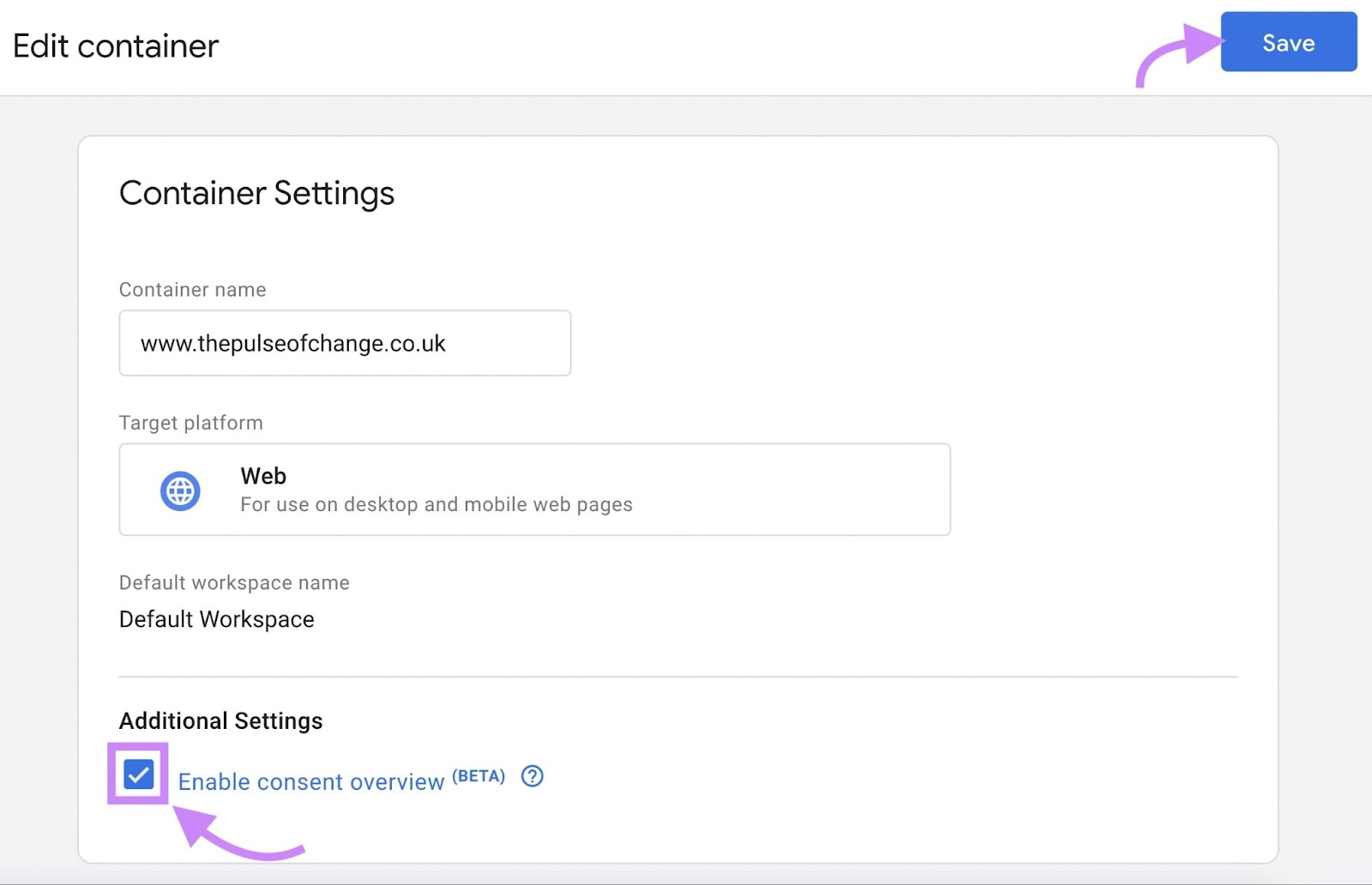
Now click on the brand new “Consent Overview” defend icon within the “Tags” field.

Choose all of your tags and click on the defend icon once more.
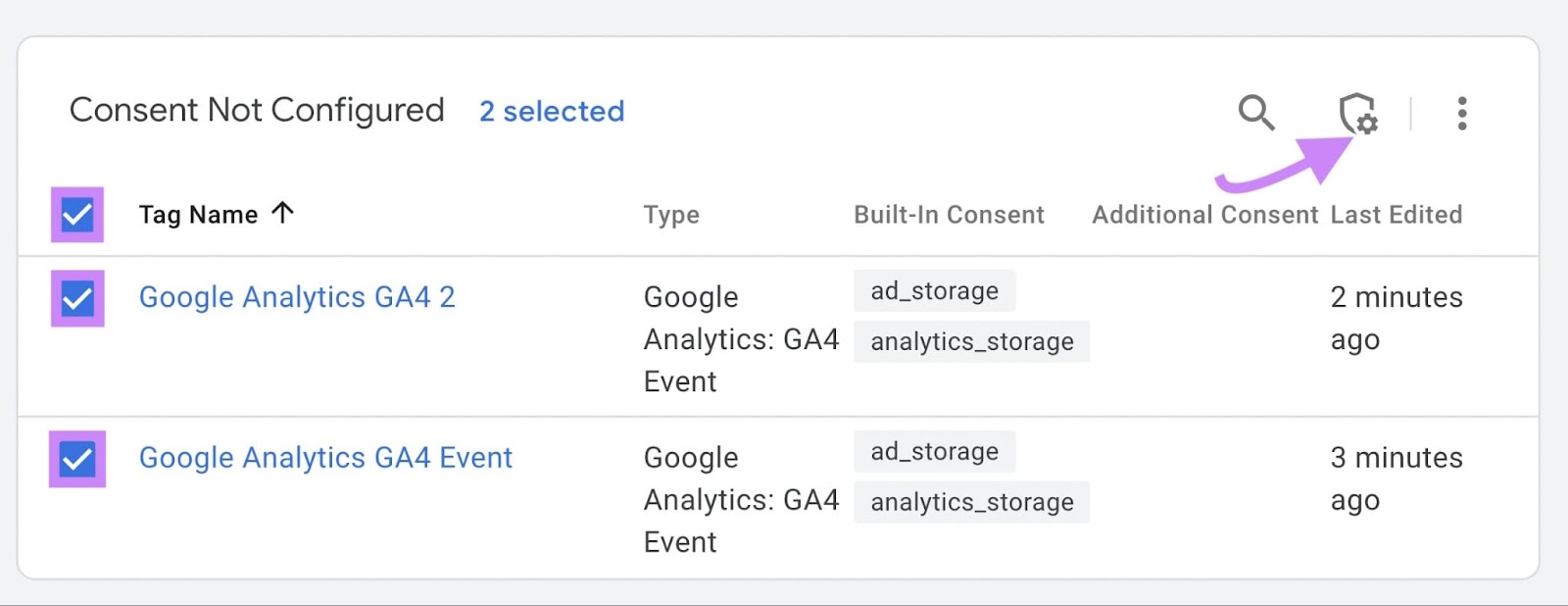
You’ll be able to enter extra consent necessities right here. In any other case, choose “No extra consent required” and click on “Save.”
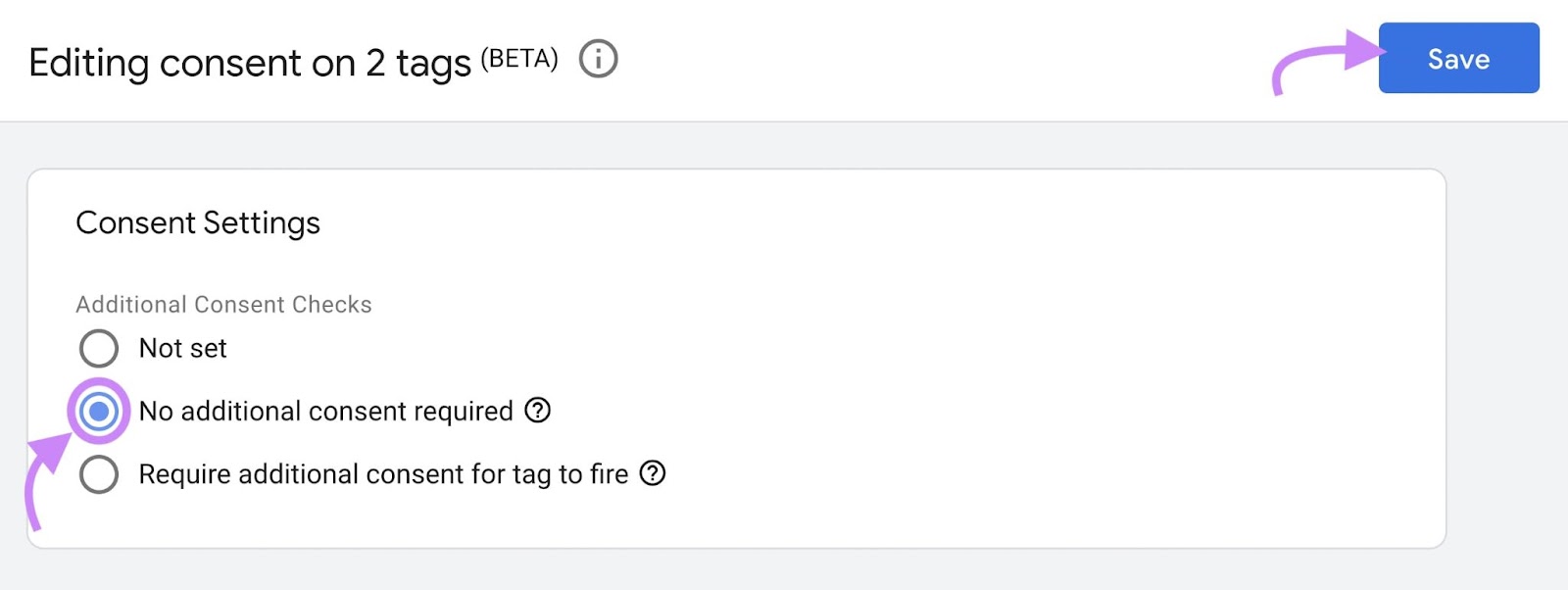
For a extra detailed walkthrough, try this Google Analytics coaching video.
4. Harness the Energy of Consumer ID and Google Indicators for Monitoring
Consumer IDs and Google alerts show you how to monitor web site customer conduct. The ensuing info helps you construct viewers profiles. You too can analyze cross-device conduct to optimize your web site for each desktop and cell units.
Consumer IDs help you collect information by assigning distinctive IDs to particular person customers who log into your web site with an account.
Google alerts help you collect information from customers who’re logged into their Google accounts once they go to your web site.
Each allow you to monitor behaviors throughout periods, units, and platforms. Right here’s tips on how to use them.
Consumer ID
Assign a singular ID to guests who create free accounts in your web site. After they improve from free to paid, you may analyze their journey in your web site as much as that second.
You too can examine signed-in customers to those that aren’t, as on this instance:
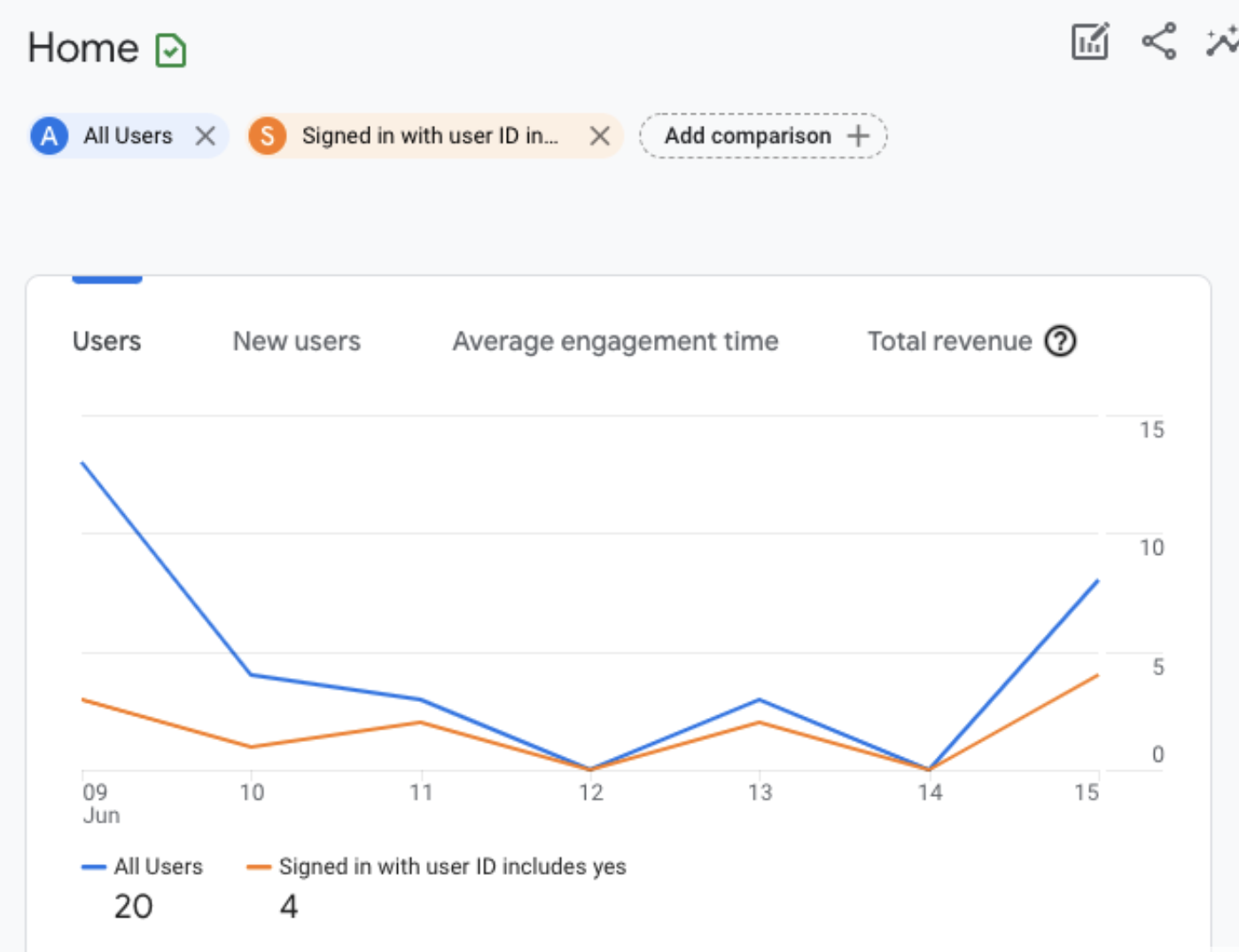
Picture Supply: Google Analytics Assist
Every consumer ID have to be fewer than 256 characters and mustn’t include personally identifiable info (PII).
To create consumer IDs, comply with the steps on this information. And contemplate consulting a developer who’s accustomed to the Google Analytics Phrases of Service.
Google alerts
To allow Google alerts, head to GA4 and click on “Admin.”
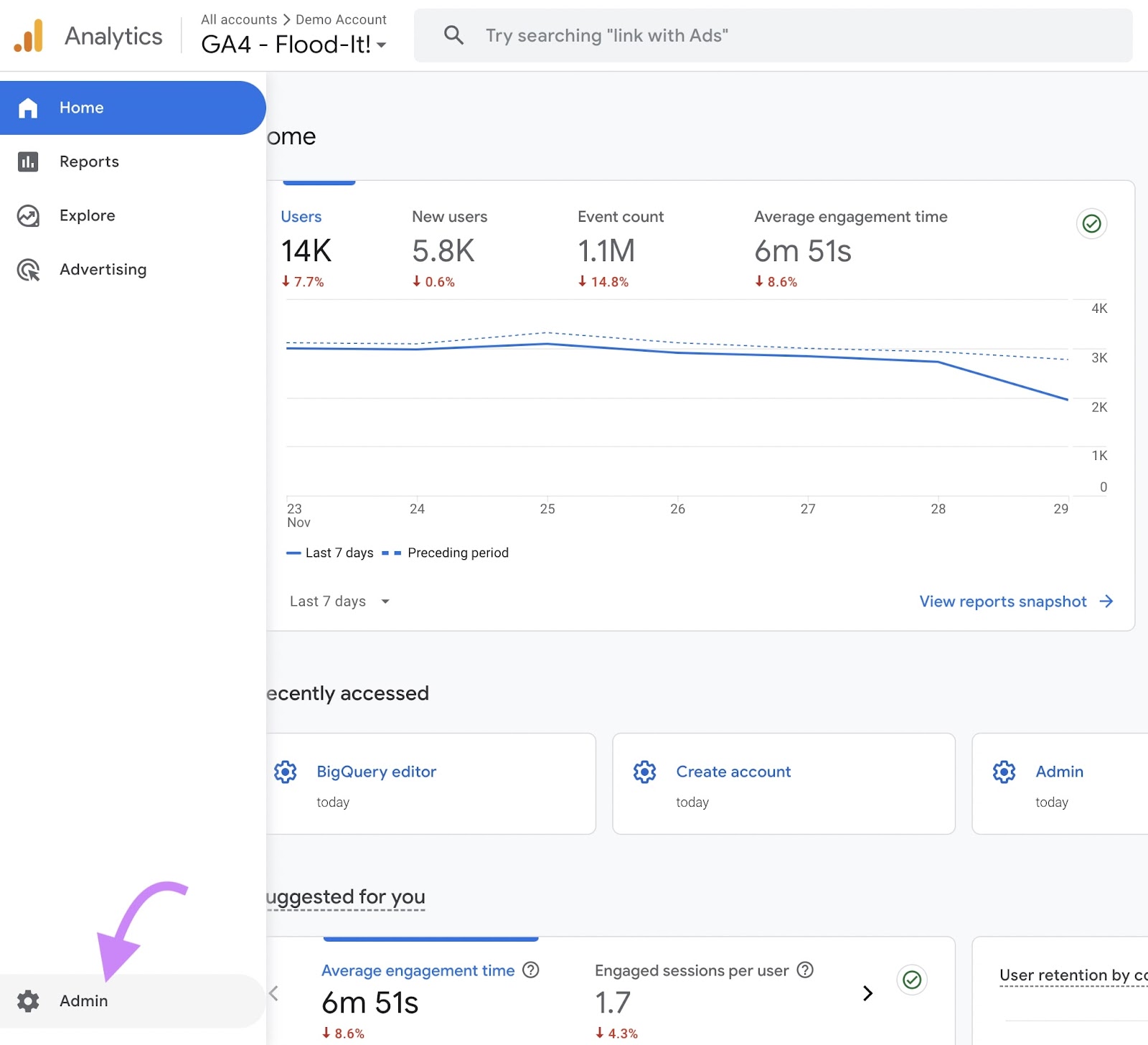
Within the “Knowledge assortment and modification” column, click on “Knowledge assortment.”
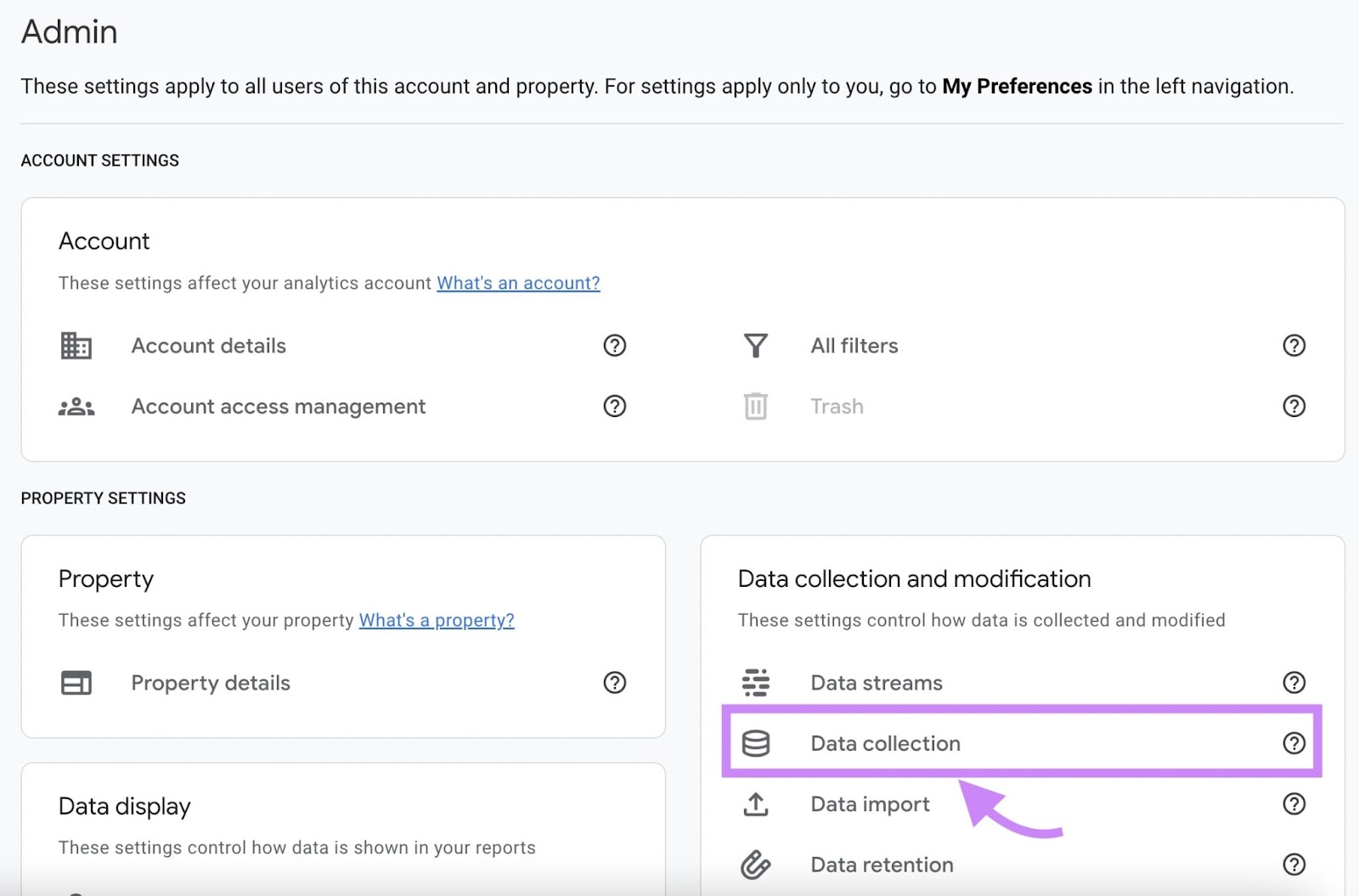
On the next display screen, click on the ‘Get Began’ button.
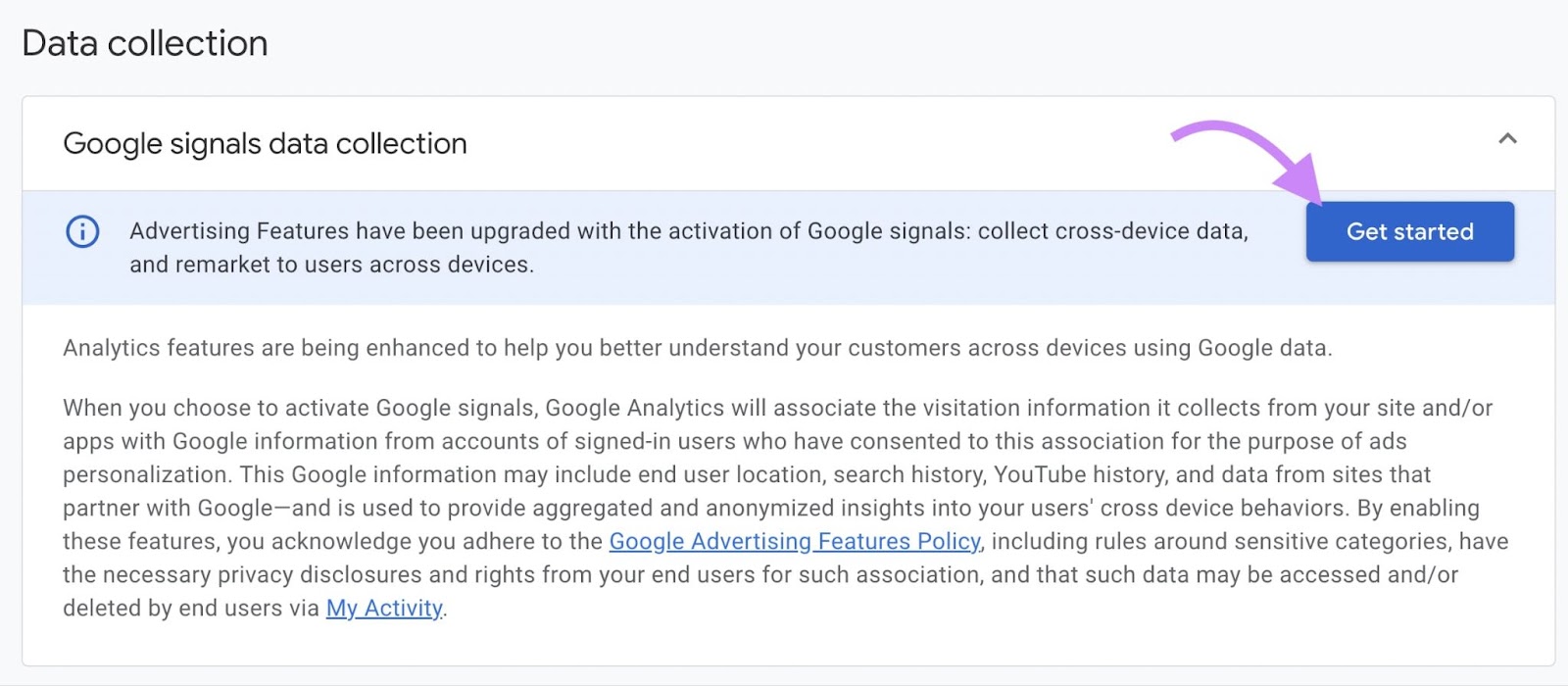
Click on ‘Proceed’ on the next display screen.
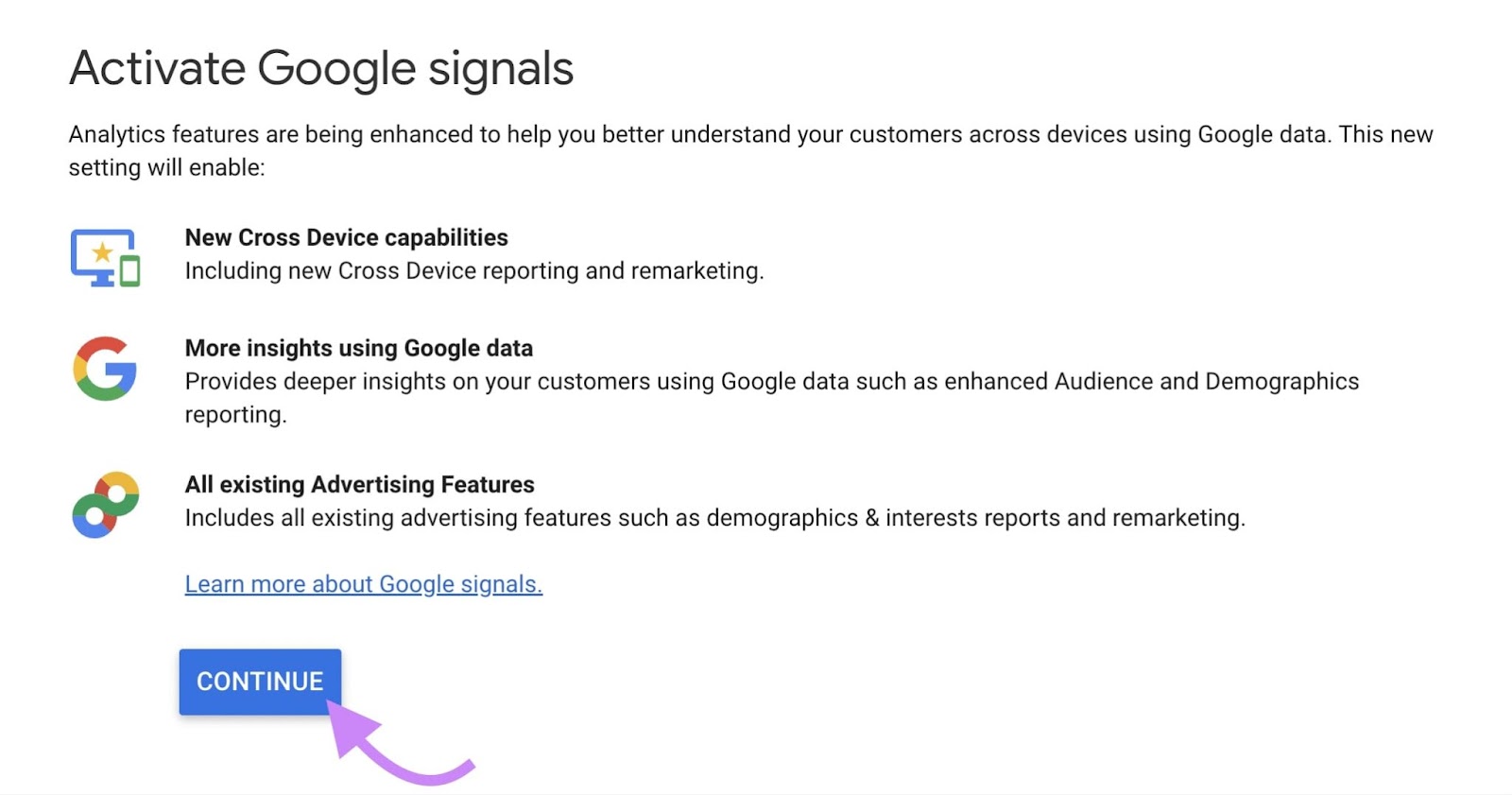
Lastly, click on ‘Activate’ to activate ‘Google alerts information assortment’.
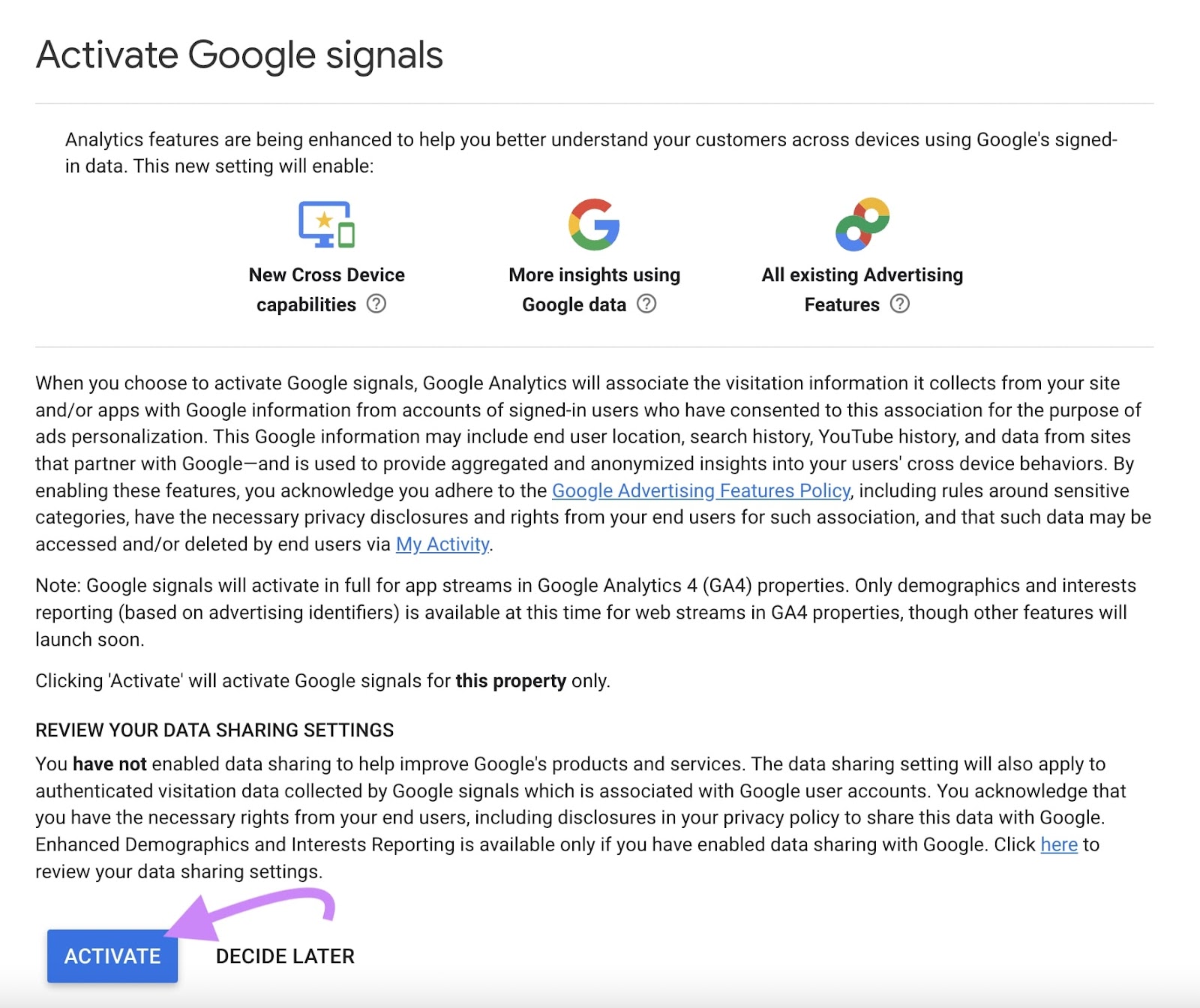
After 24 hours, Google will populate your Demographics overview report with nameless information on these customers.
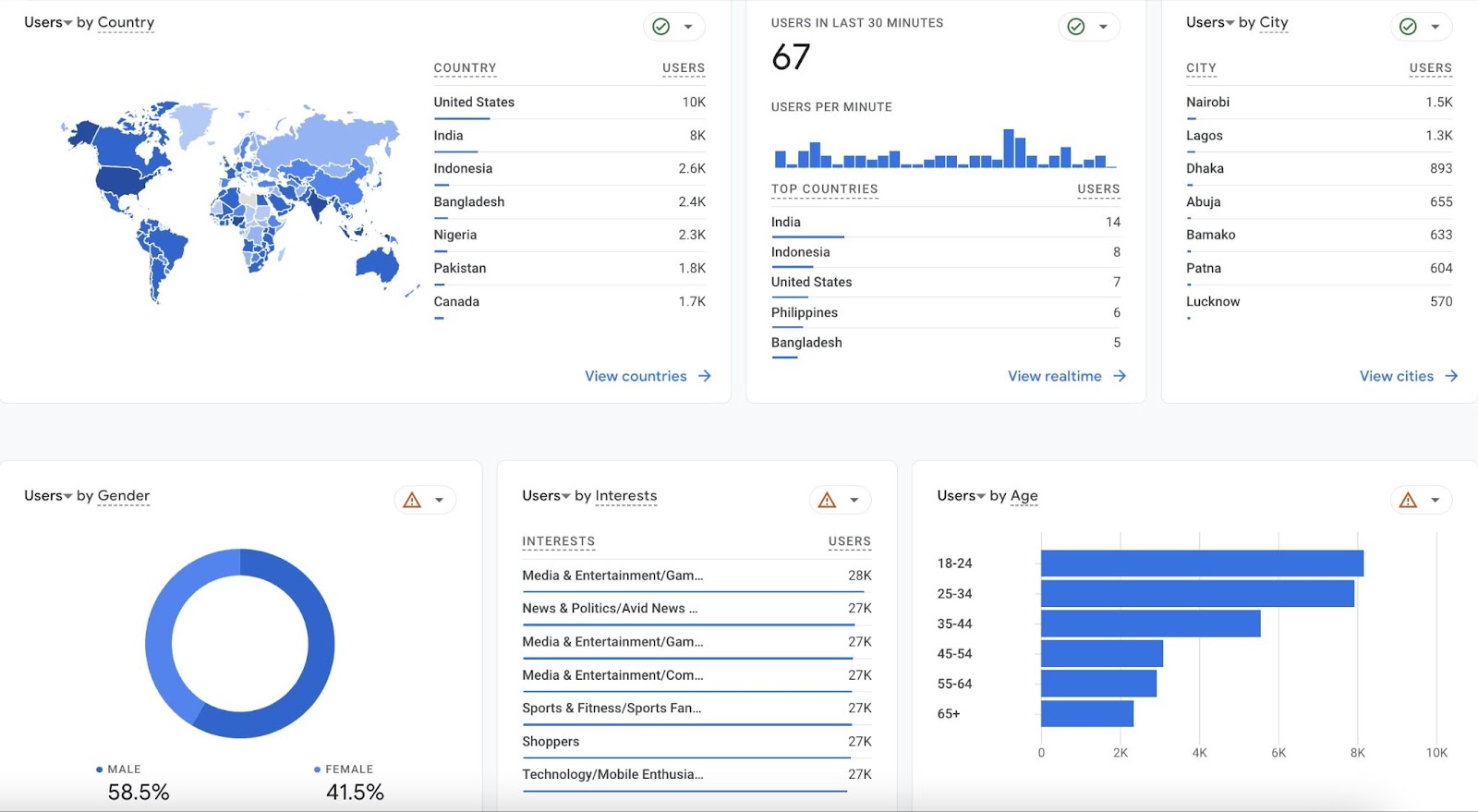
Understanding cross-device behaviors like these lets you supply extra related adverts to customers and optimize spend primarily based on utilization.
5. Flip Your Customized Funnels Right into a Commonplace Report
Turning customized funnel explorations into normal experiences makes them simpler to entry with fewer clicks. Permitting you to optimize your app or web site’s advertising and marketing funnel.
A customized funnel exploration is an information visualization of the client journey. It reveals you the way customers full duties in your web site, how lengthy it takes them to take action, and the place customers drop off alongside the best way.
Nevertheless it takes loads of clicks to navigate to this info. By comparability, a regular GA4 report is simpler to entry and analyze out of your homepage.
Guess what: You’ll be able to mix the advantages of each.
Right here’s what your customized funnel exploration may appear like as a regular report:
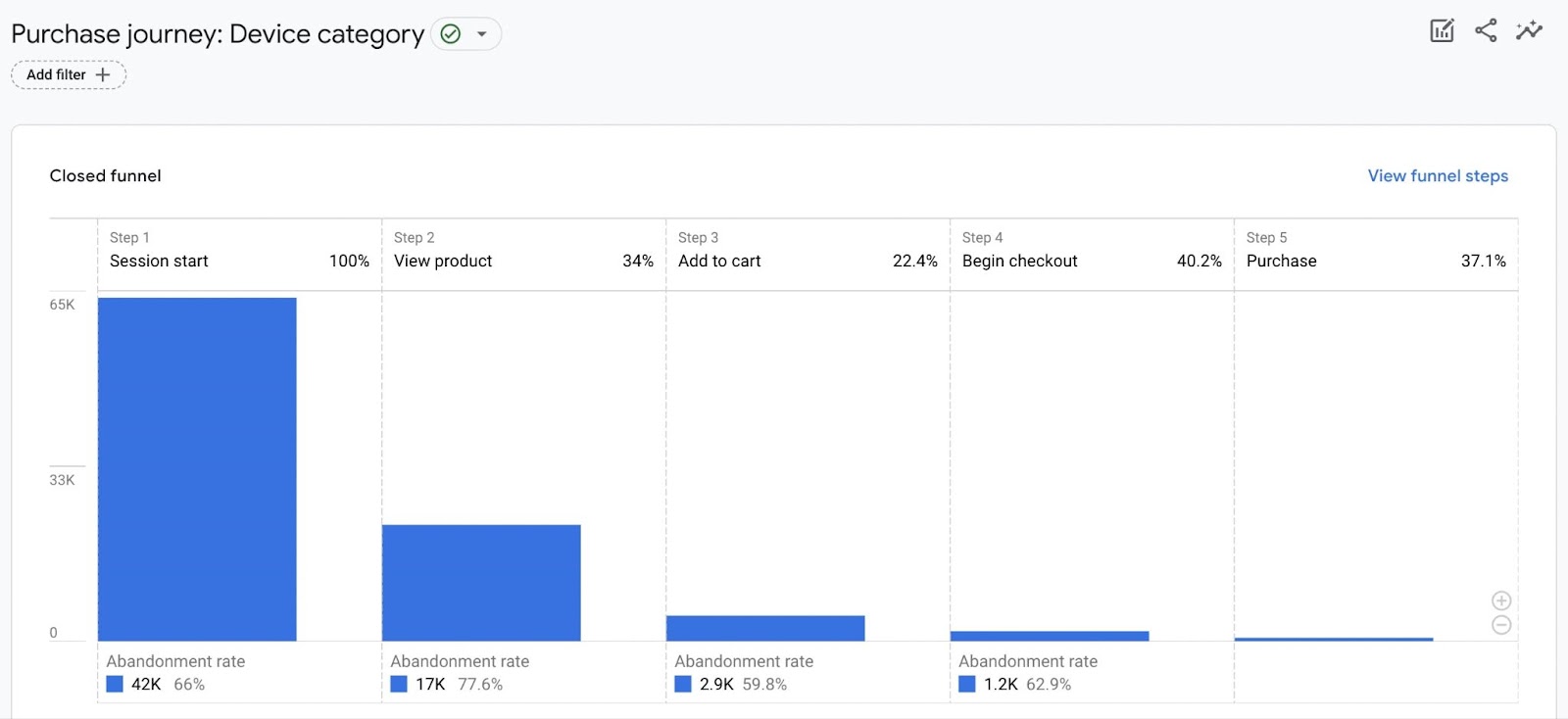
To get began, comply with the steps on this information to create a funnel exploration. Then click on the “Save as a report within the Library” button.

Give your customized funnel a particular title and outline. Then click on “Save.”
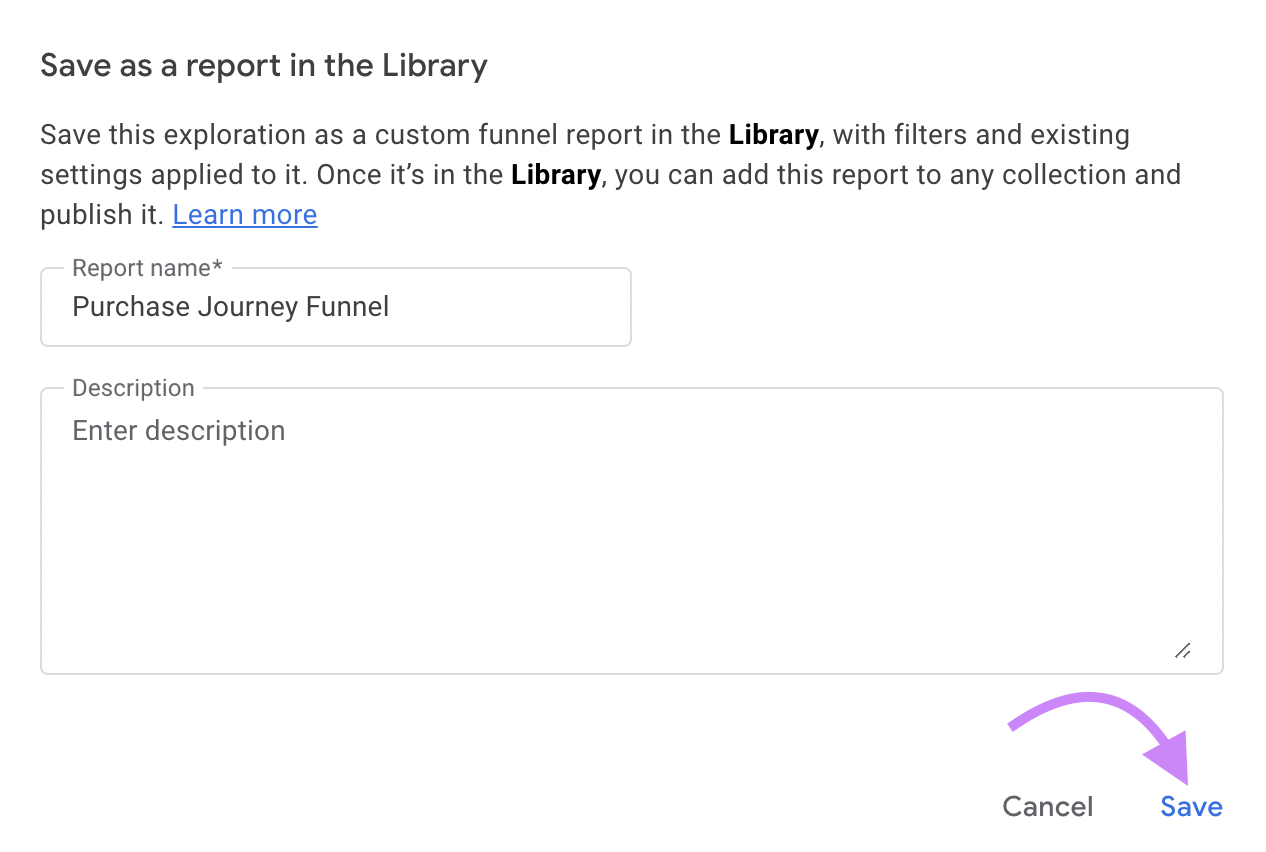
After that, head to the “Experiences” tab on the left sidebar. Click on “Life cycle,” then “Monetization.”
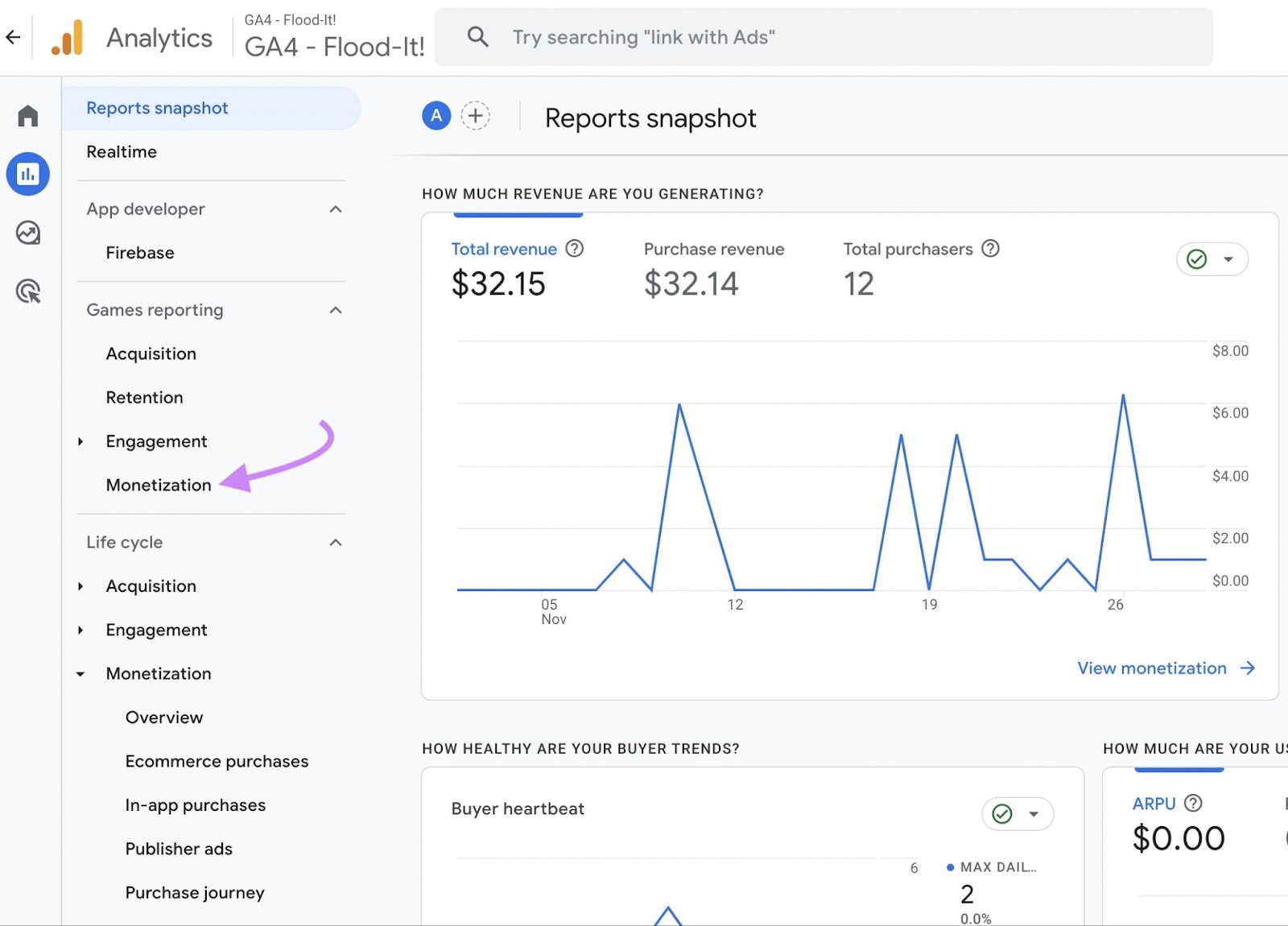
On the underside left of the display screen, click on “Library.”
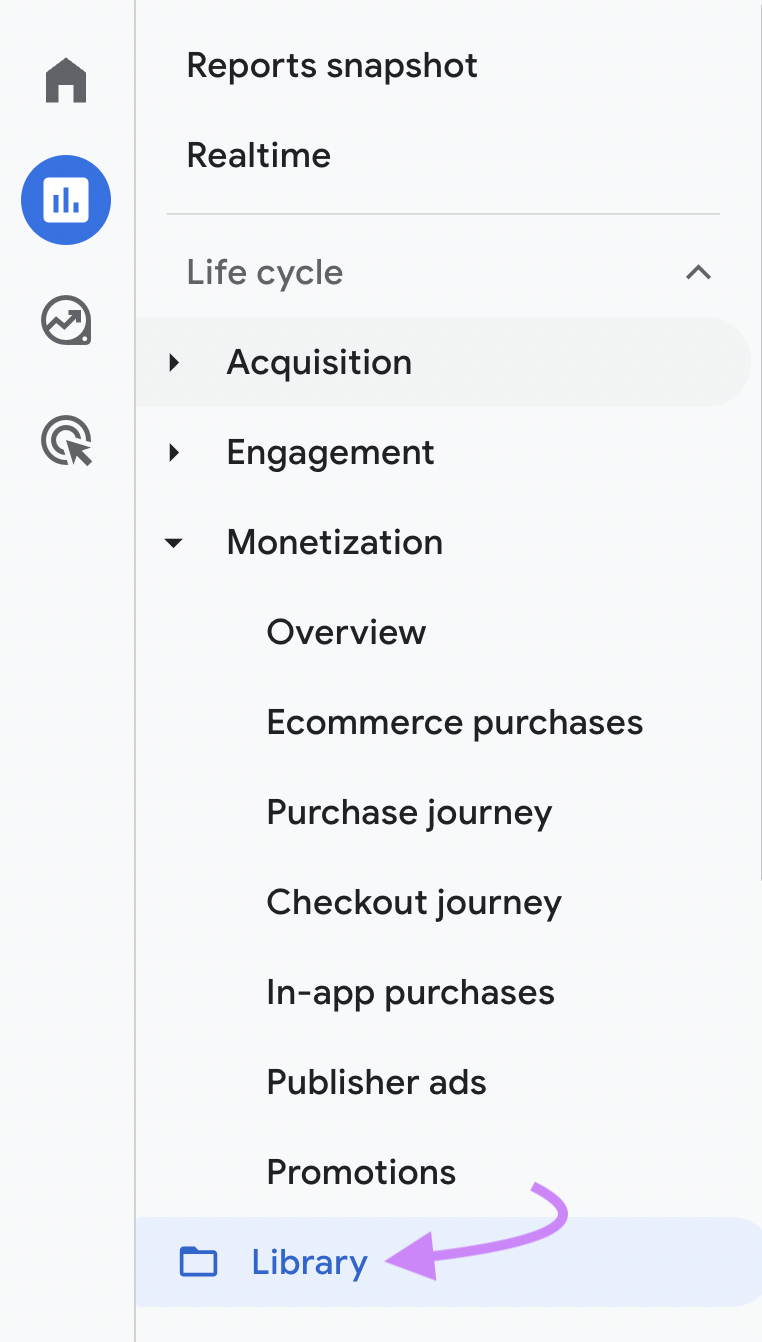
Underneath the “Life cycle” tab, click on “Edit assortment.”
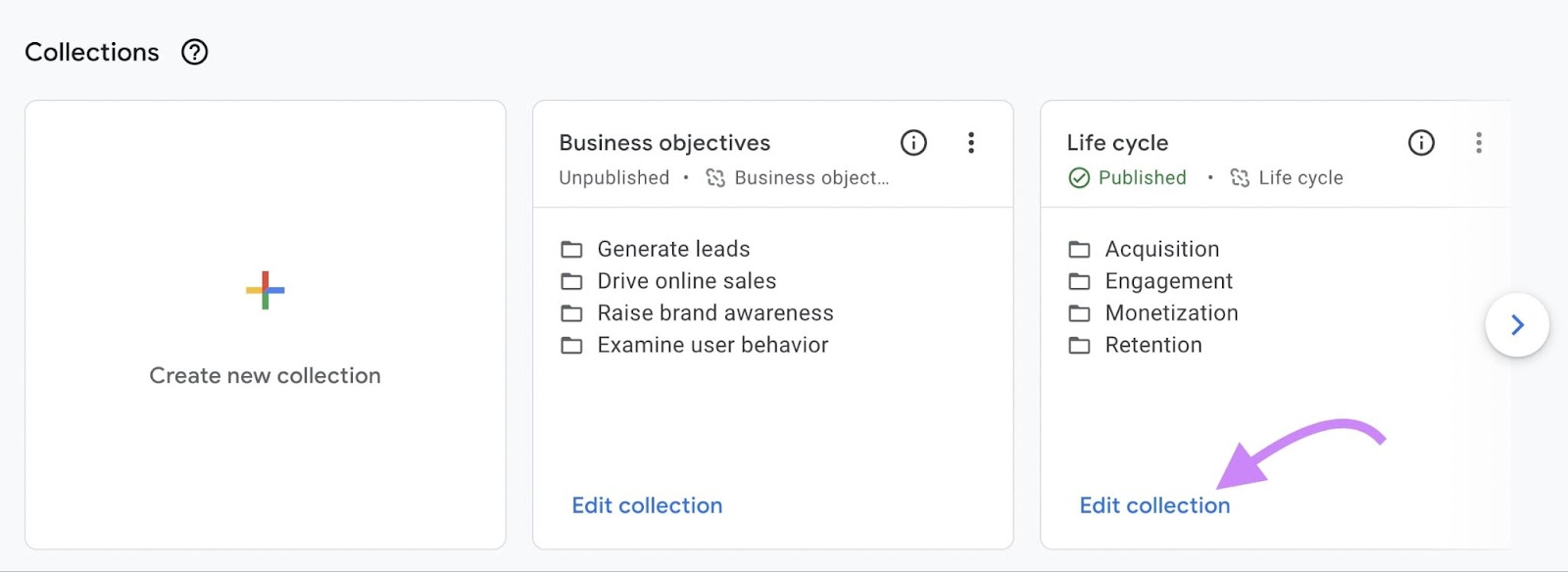
Scroll down to seek out your customized funnel. Then drag and drop it into the “Monetization” sidebar on the left.
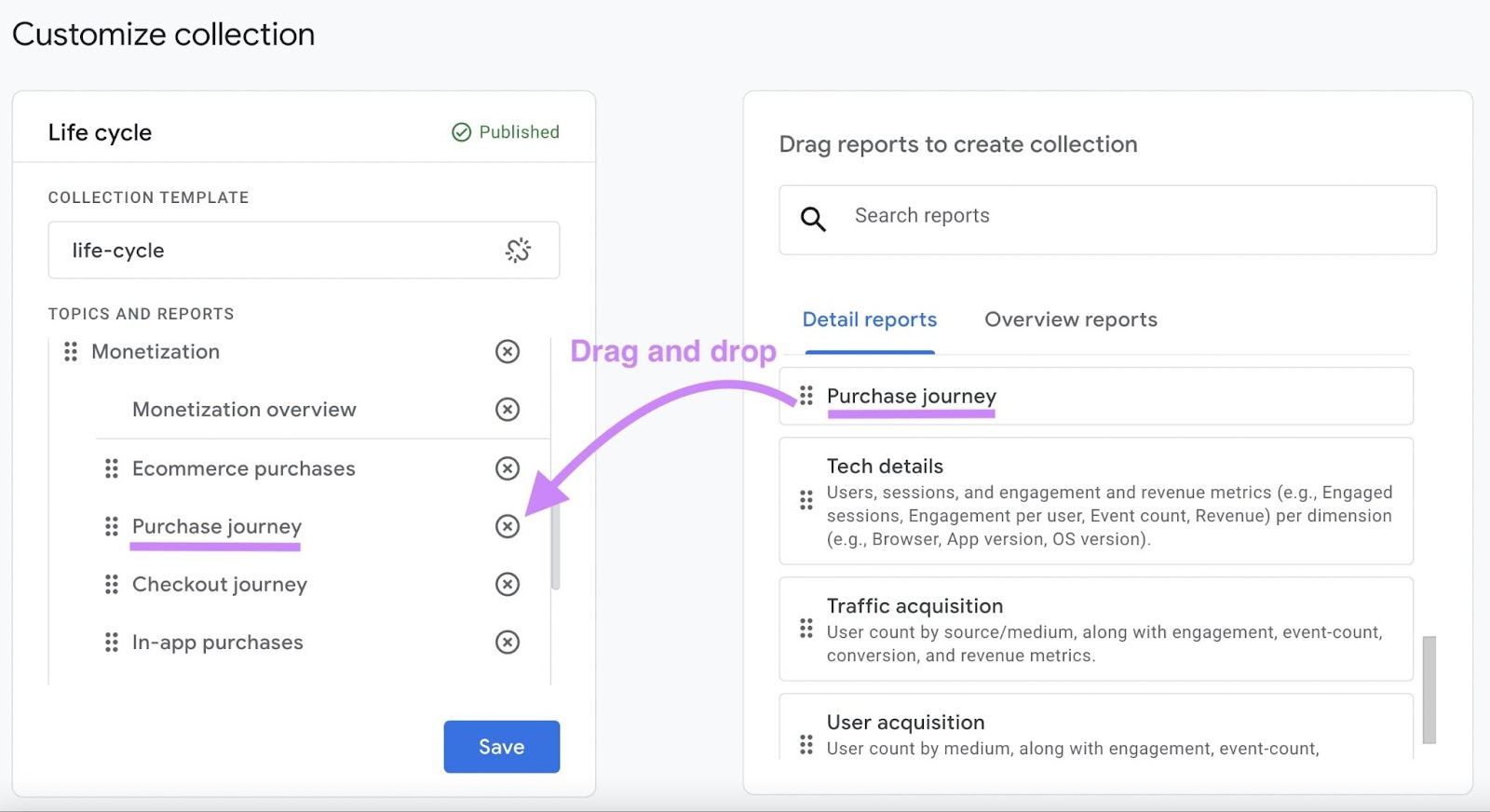
Click on “Save” and choose “Save modifications to present assortment.”
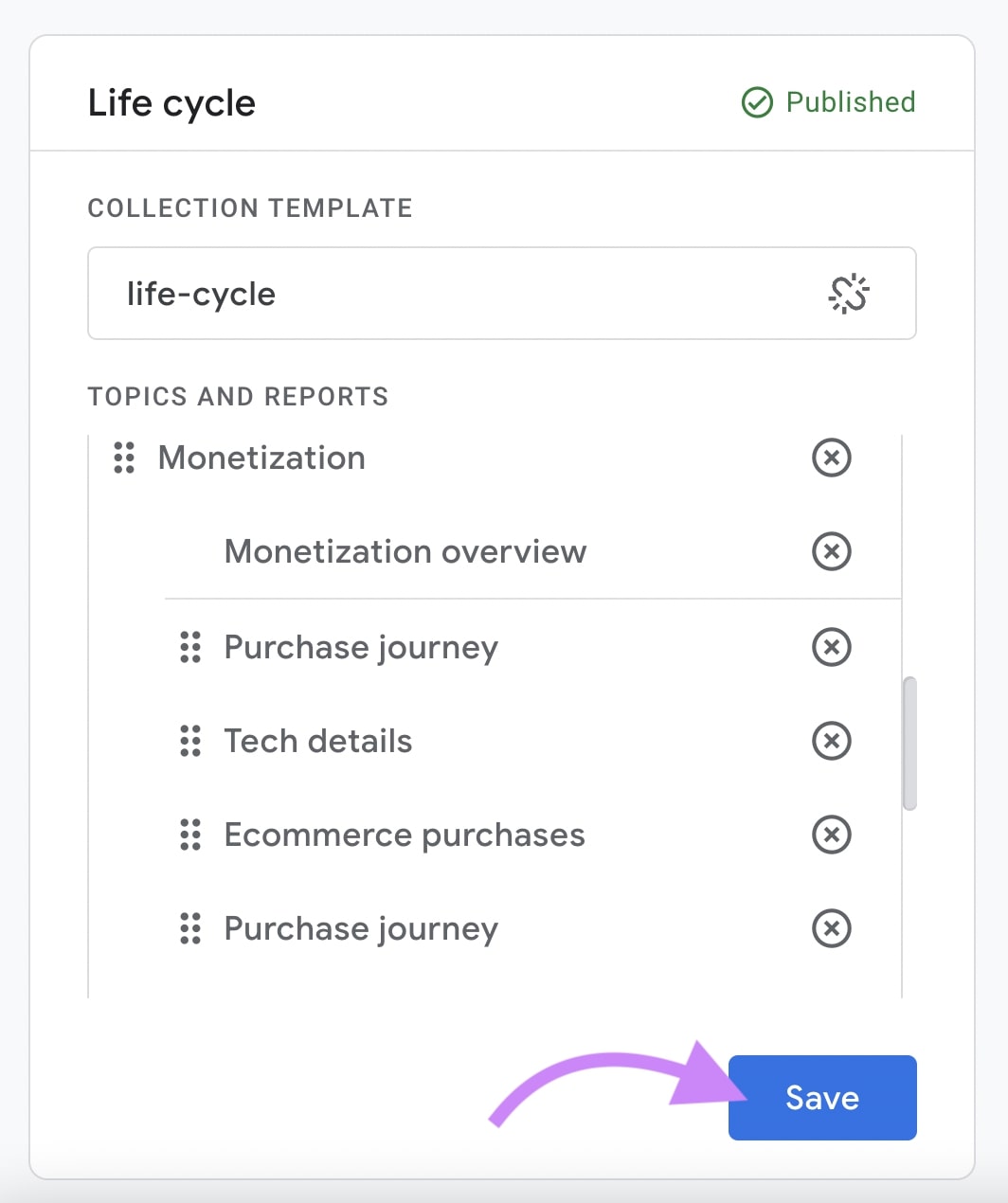
Now you’ll see your funnel exploration as a customized report while you head to your “Monetization” tab.
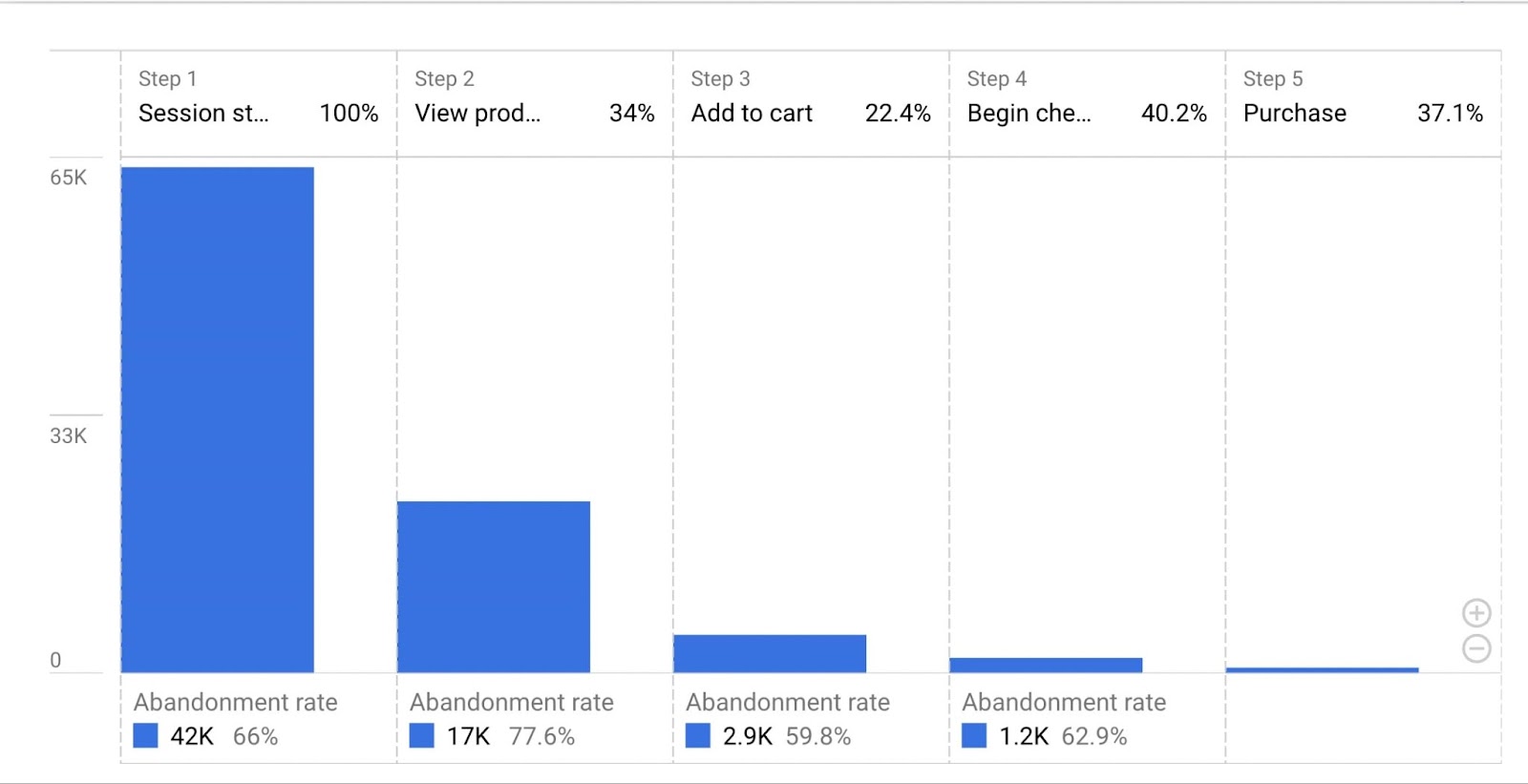
In consequence, your most vital insights are accessible solely a few clicks away.
6. Verify for Knowledge Anomalies to Spot Issues and Alternatives
Monitor information anomalies in GA4 to identify irregular information patterns. And use the findings to mitigate long-lasting issues or spot progress alternatives.
A knowledge anomaly in GA4 is an surprising change within the information. It may be constructive or destructive.
For instance, this sudden spike in customers is an anomaly:
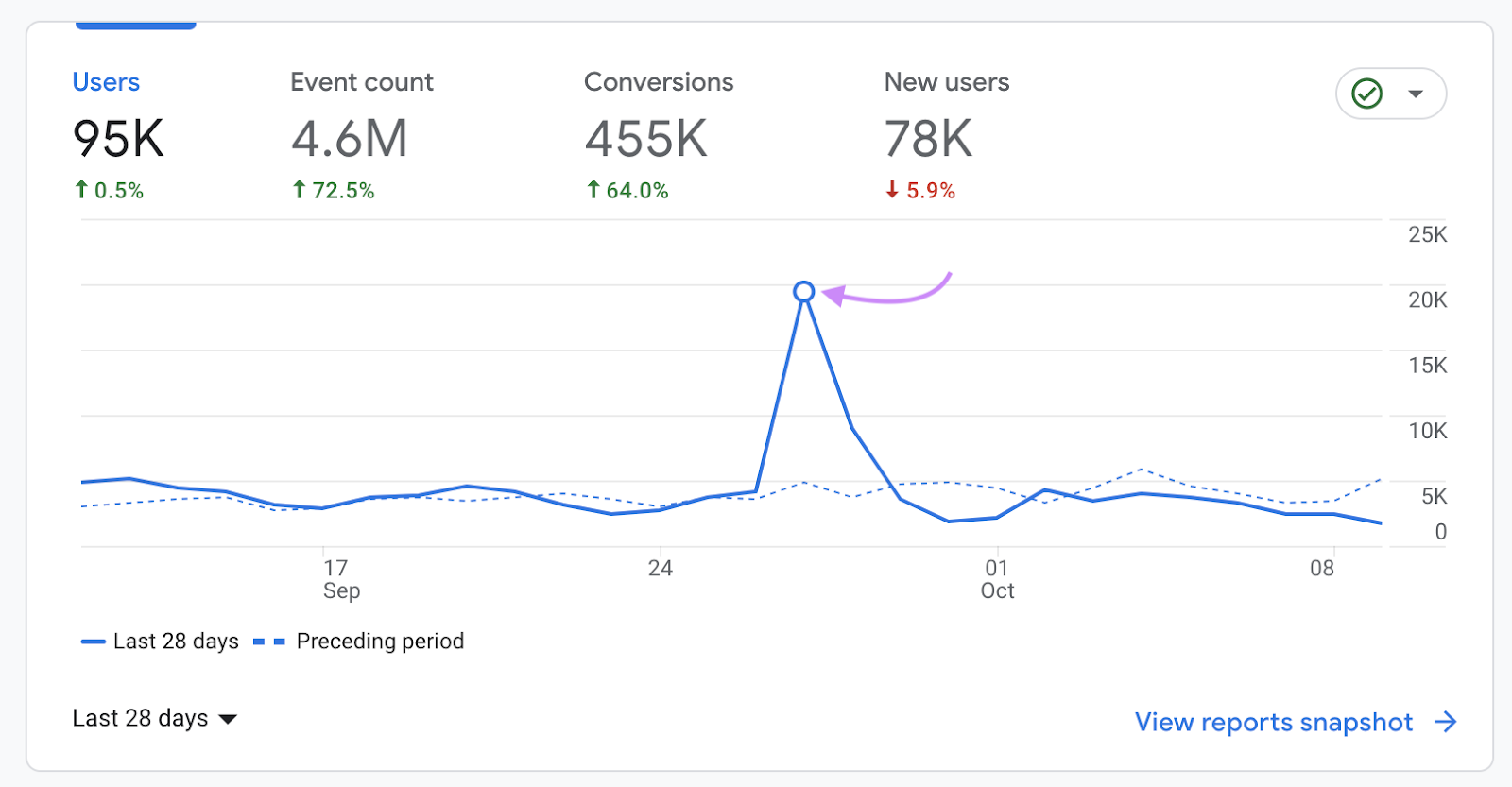
It’s vital to trace anomalies like this and determine why they occurred.
What prompted the sudden inflow of customers to your web site?
Was it a brand new Google Advert? An influencer sharing your content material on social media? A point out on a podcast?
Discovering the reply can assist you replicate the success extra typically. Doing the identical for destructive anomalies can stop points from spiraling downward.
There are a number of methods to seek out these spikes and drops.
Head to the “Residence” web page of your GA4 account and scroll right down to “Insights & suggestions.” Right here you’ll see an inventory of anomalies Google thinks are most vital.
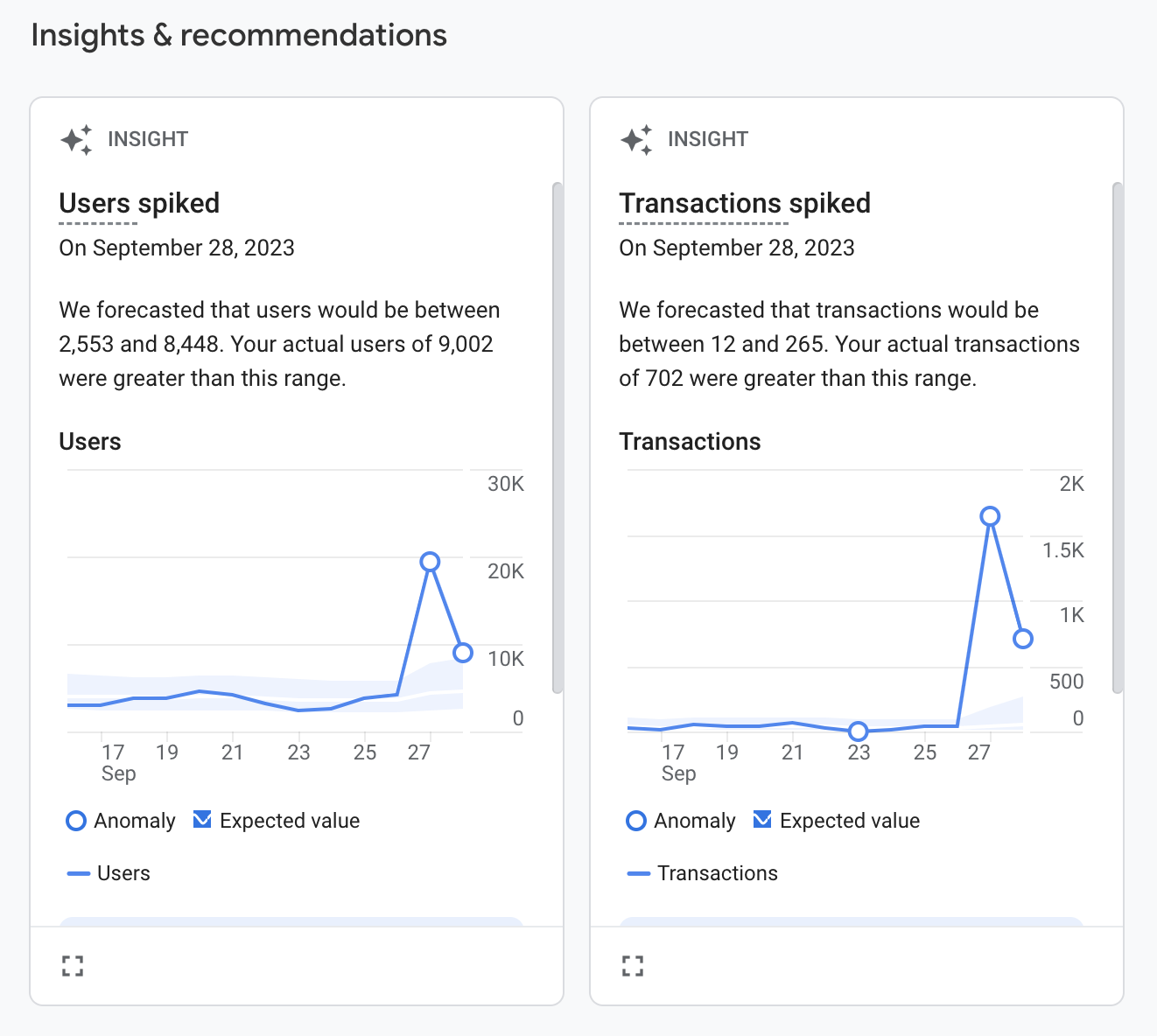
On this case, you may see that customers and transactions spiked on the identical day. The location doesn’t inform you why. However you may dig a bit deeper to seek out the causes.
In case your web page is stuffed with anomalies like these, click on “View all insights” to see them.
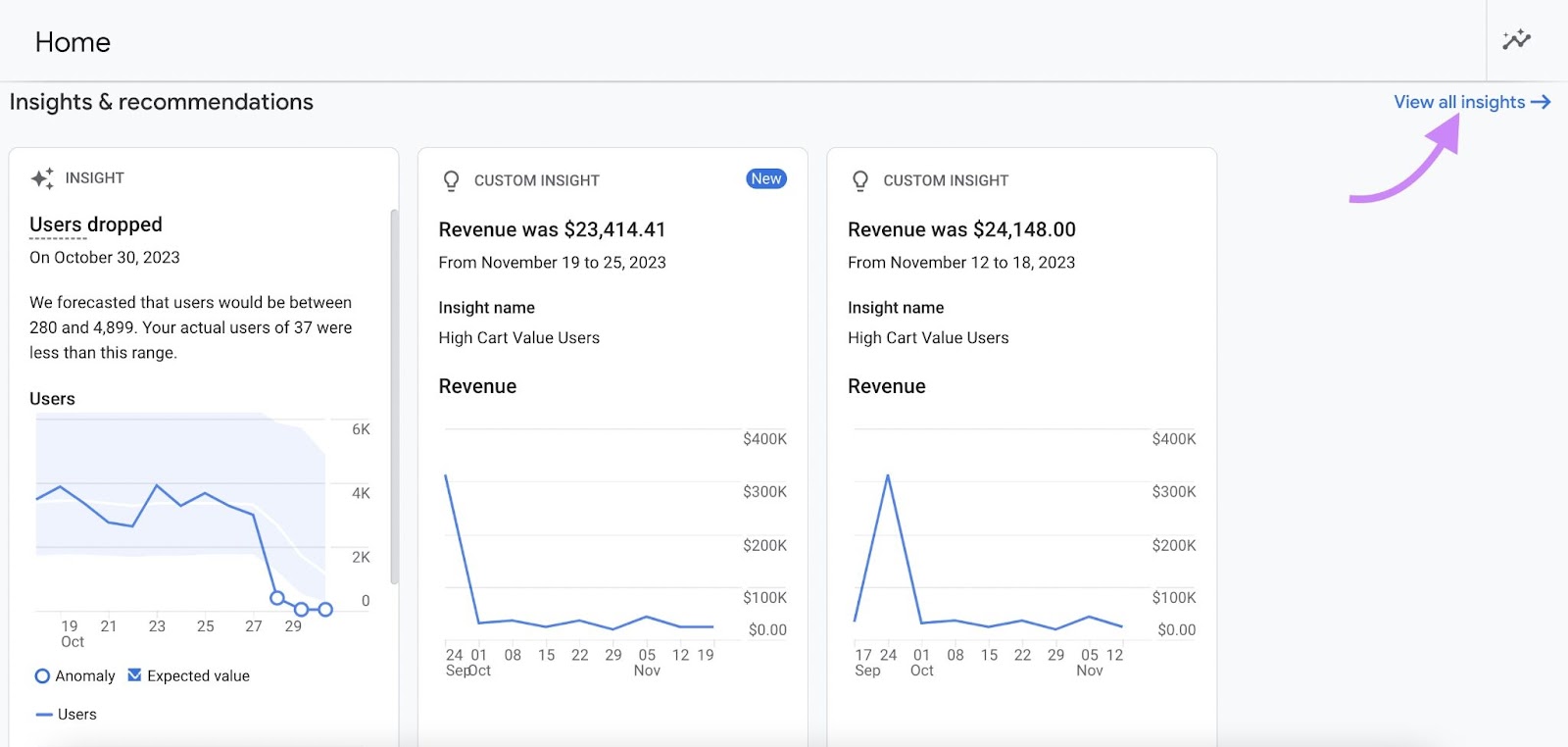
Click on on any you’re excited by to view the main points in the precise pane.
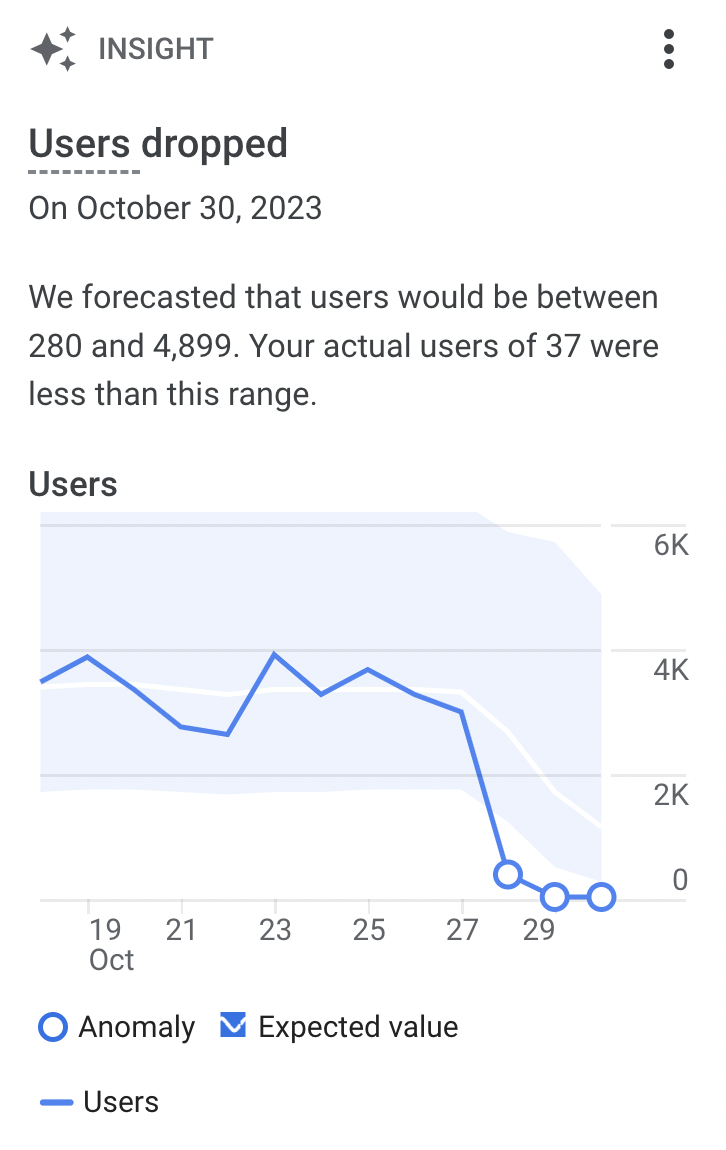
You too can verify for anomalies within the “Discover” tab. Head again to “Residence” and click on “Discover.”
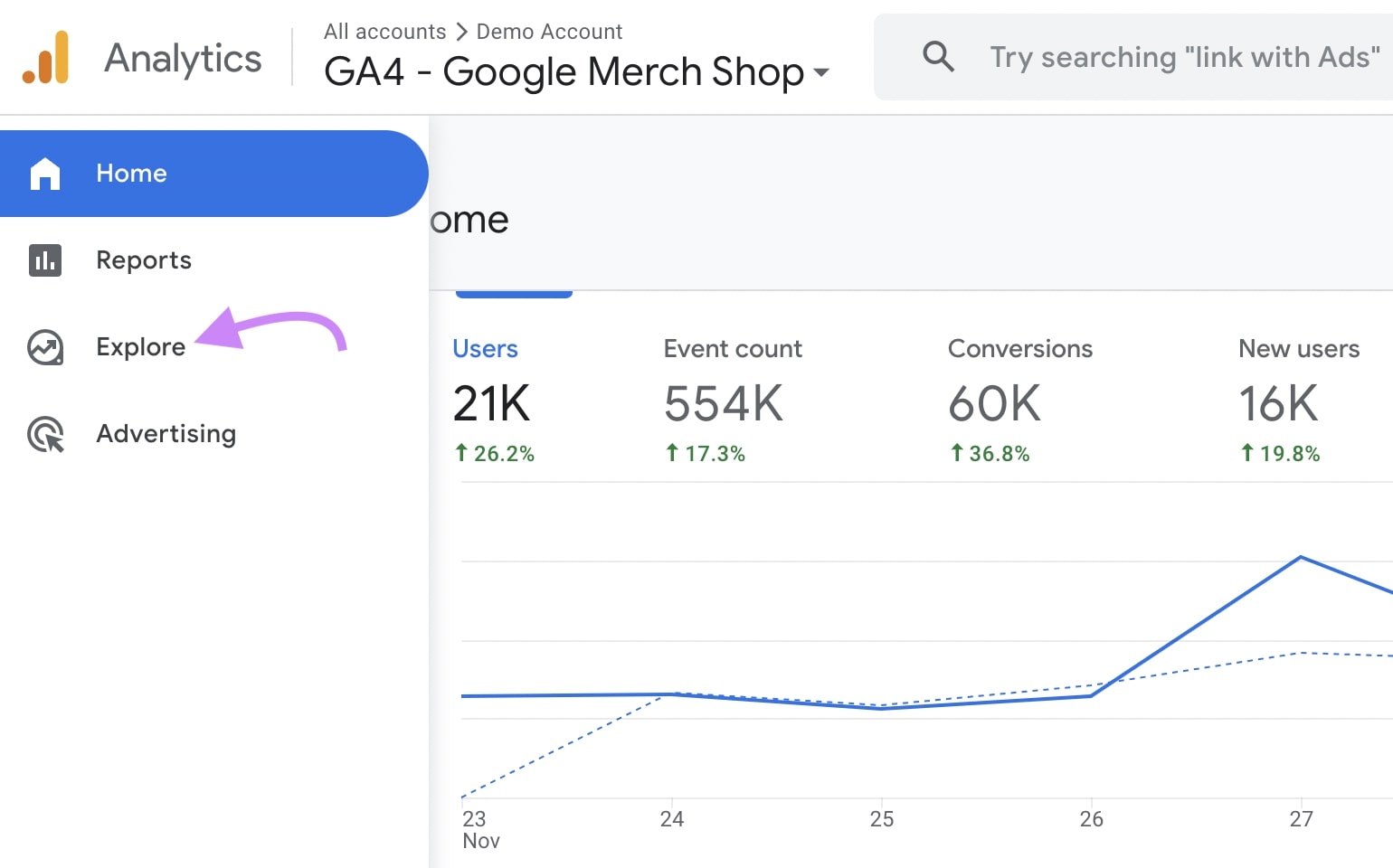
Then choose a “Free type” exploration.
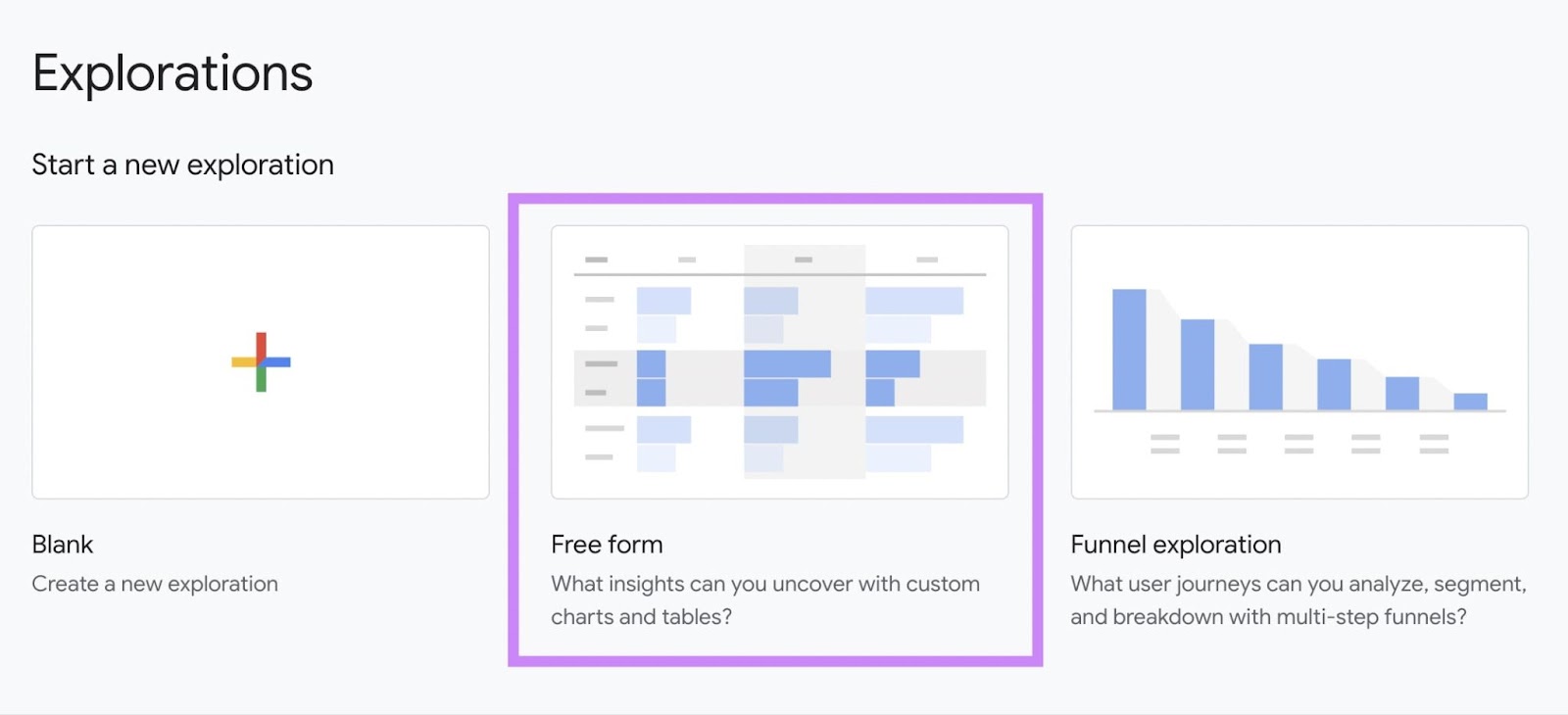
Within the Settings pane, click on “Line chart.”
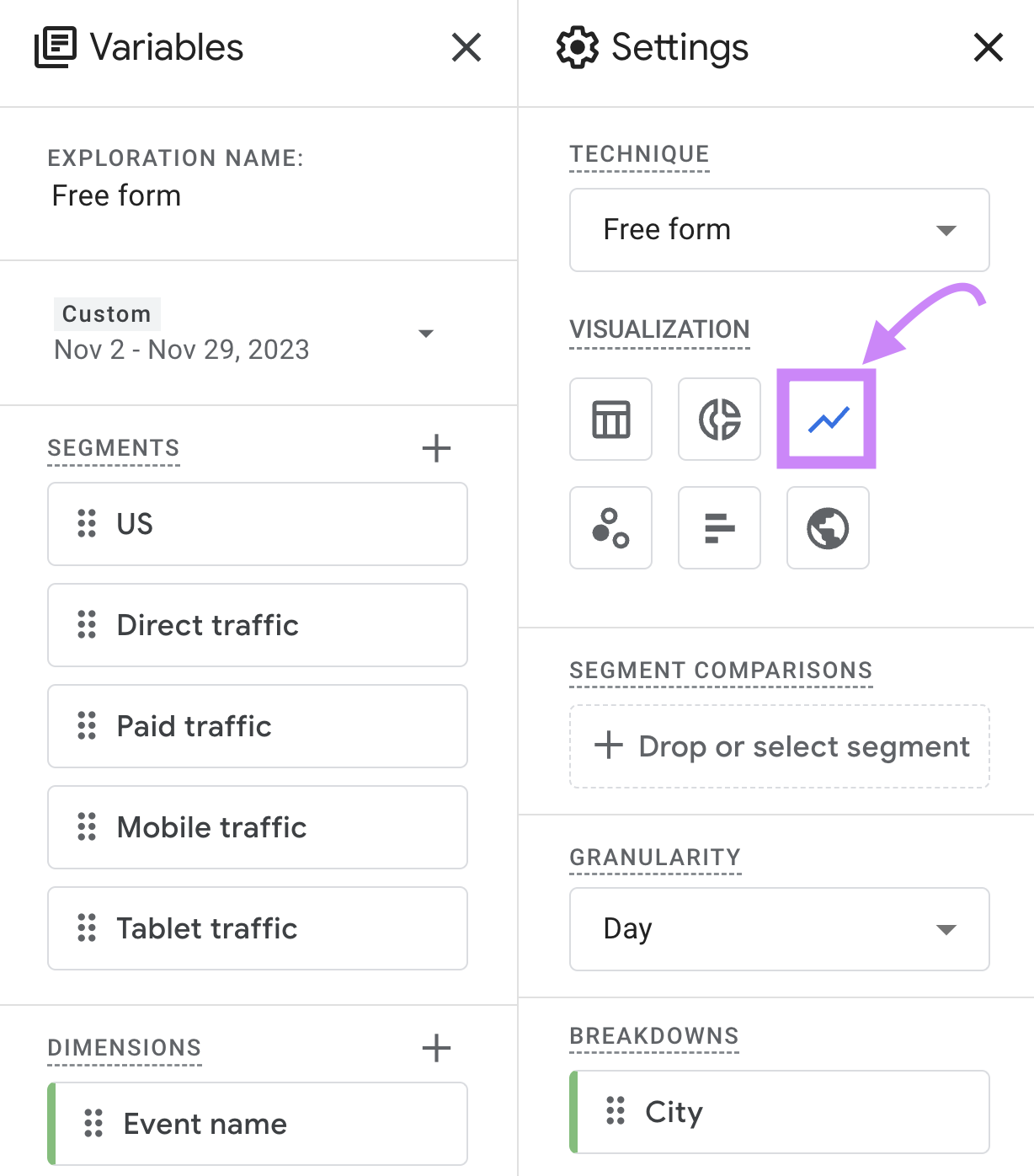
That makes information spikes extra apparent. However on this case, GA defaulted the information factors to Cities.
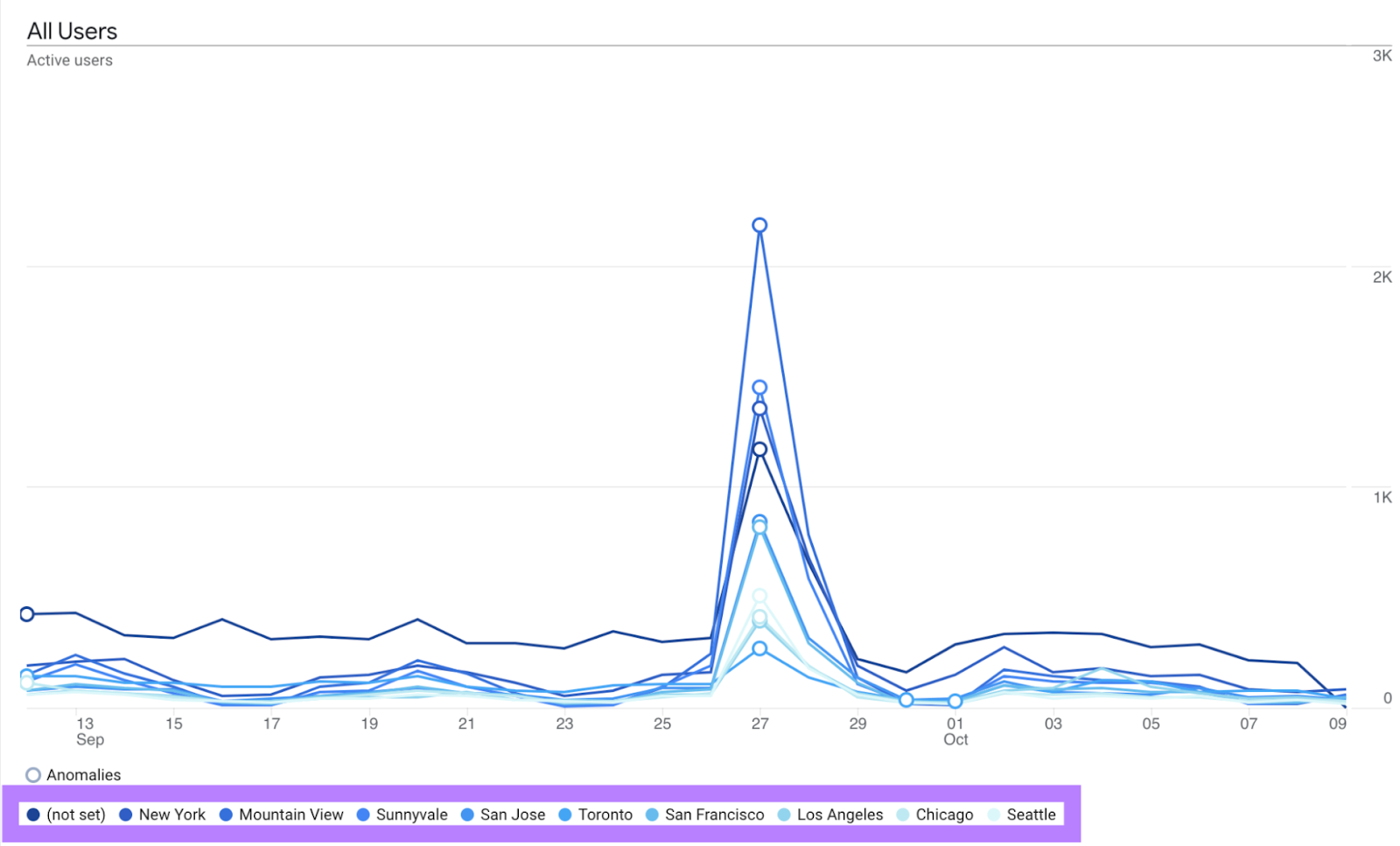
To alter this breakdown, click on the “+” button within the “Dimensions” tab on the left.
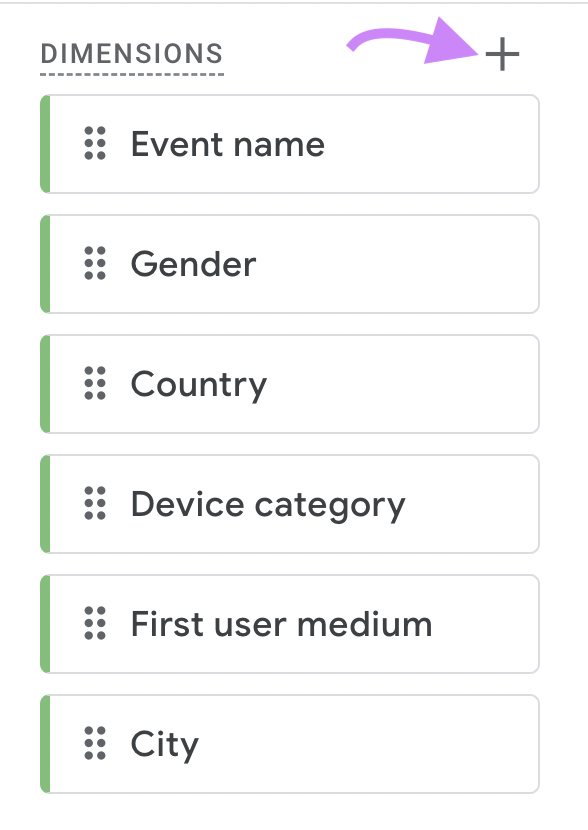
Then kind “session supply / medium” into the textual content field. Verify the field and click on “Import.”

Then drag this new Dimension into the “Breakdowns” tab.
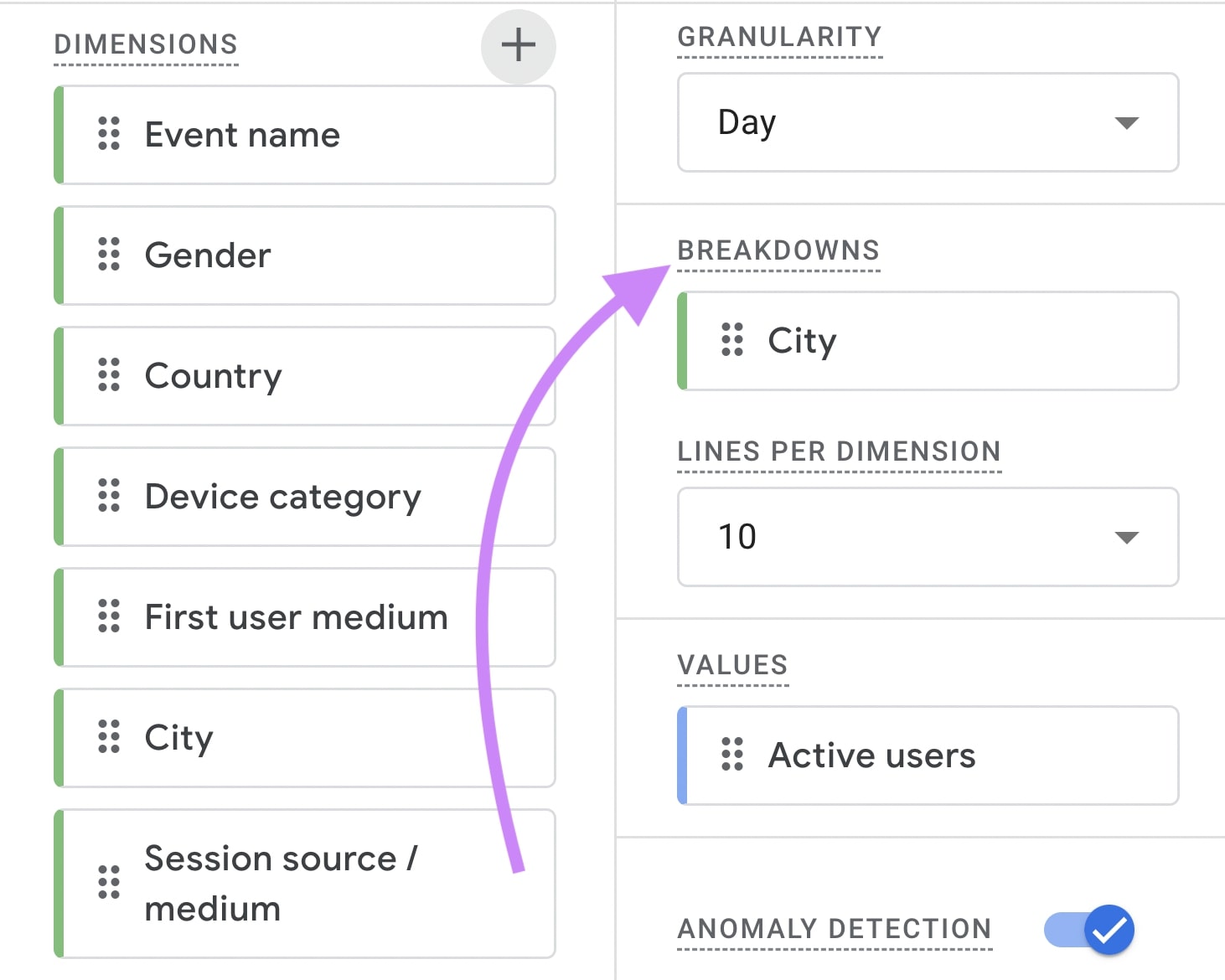
Click on the “X” that seems while you hover over Metropolis to delete the “Metropolis” filter.
Now our linear graph breaks down information factors by supply:
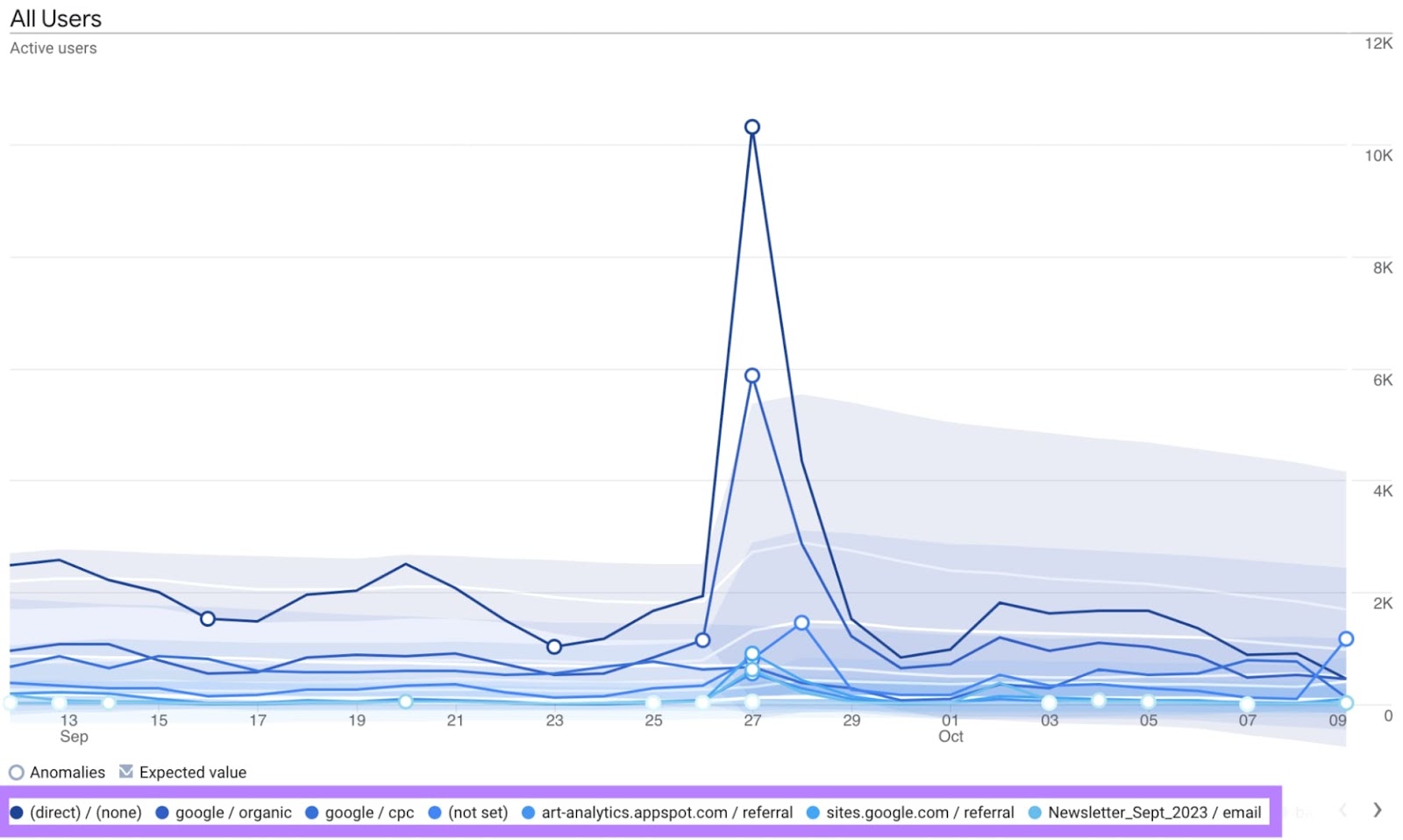
Click on on any of those sources to view their particular traces and spikes.
Right here we will see that the largest spike got here from direct site visitors:
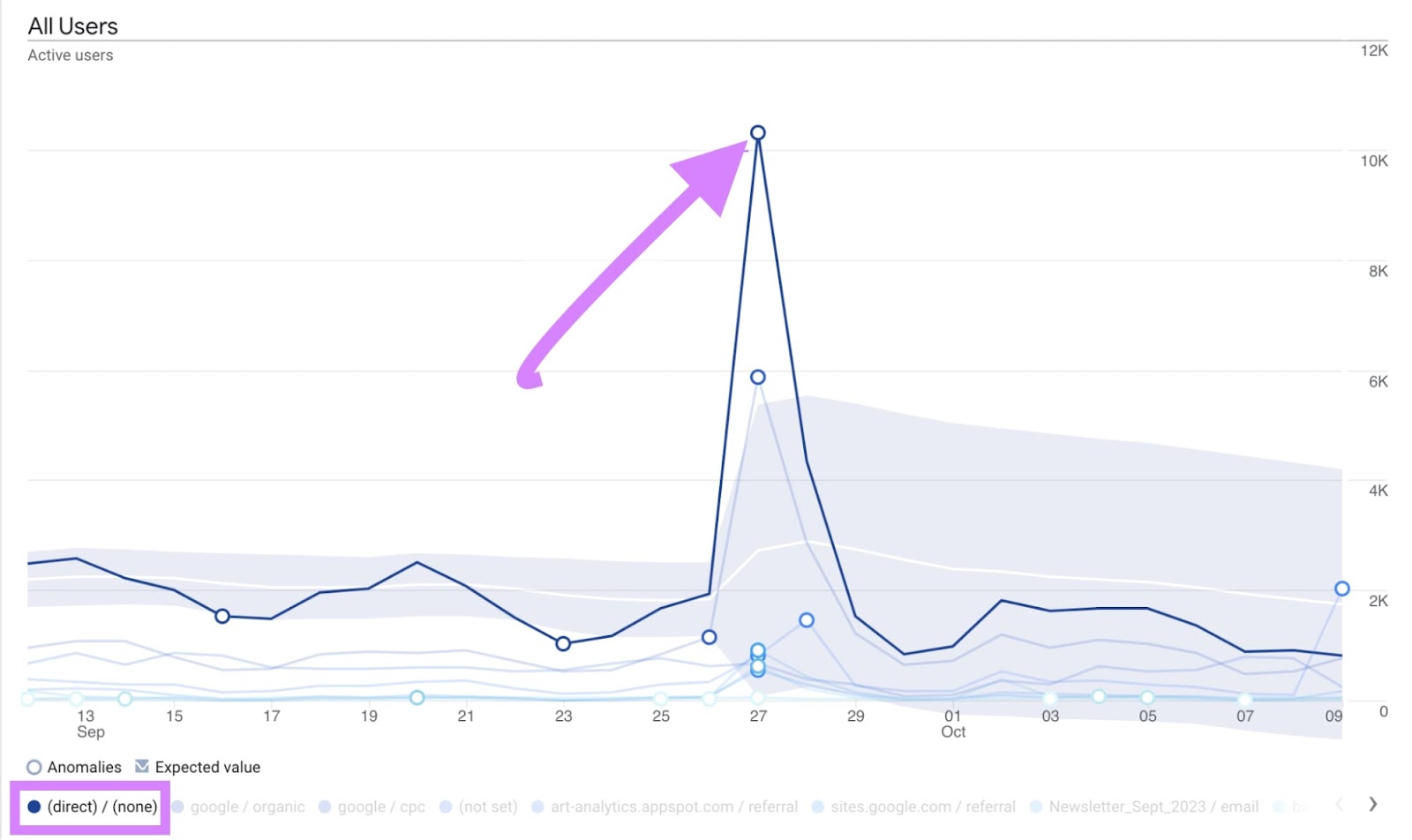
While you hover over the information level, you’ll discover that it says “Anomaly detected.” Together with the precise metric, anticipated metric, and proportion distinction.
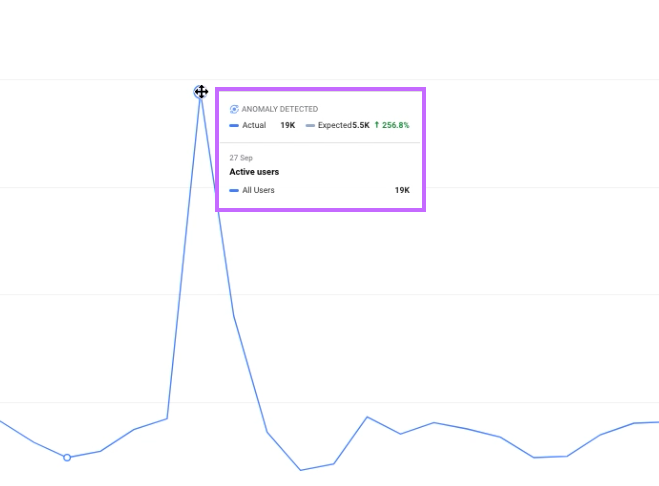
Direct site visitors sources recommend somebody talked about your model. So you should use anomaly detection in GA4 to start out your analysis.
7. Perceive New Definitions for Every Metric
You’ll want to perceive base-level metric definitions in GA4 and the way they’ve modified since UA. So that they don’t throw off your calculations and decision-making.
Listed here are a number of of the basic metrics you’ll in all probability work with:
Classes
Classes are visits to your web site from a number of site visitors sources. They finish when customers depart or outing after half-hour of inactivity.
They include all consumer actions and actions in your web site.
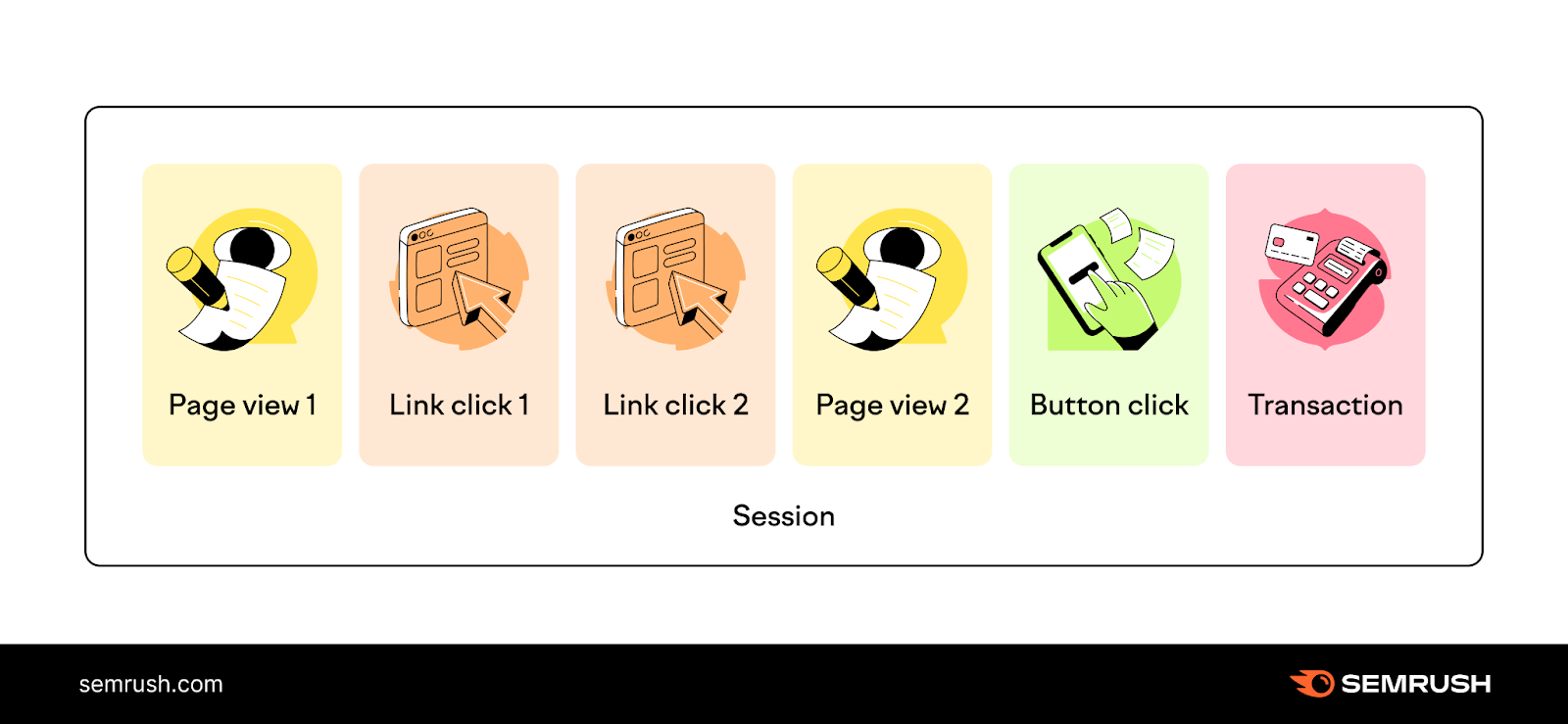
Let’s say a consumer leaves your web site to log in to Google. After they return to your web page, GA4 counts this state of affairs as one session with a number of site visitors sources.
In UA, it will depend as two separate periods.
Engaged Classes and Customers
Engaged periods are a brand new metric for GA4. They embrace any session that meets one of many following standards:
- Lasts longer than 10 seconds
- Spans two or extra web page views
- Entails scrolling to the underside of the web page
- Ends in at the least one conversion
In GA4, individuals with an engaged session are “Energetic customers” (known as “Customers” in experiences).
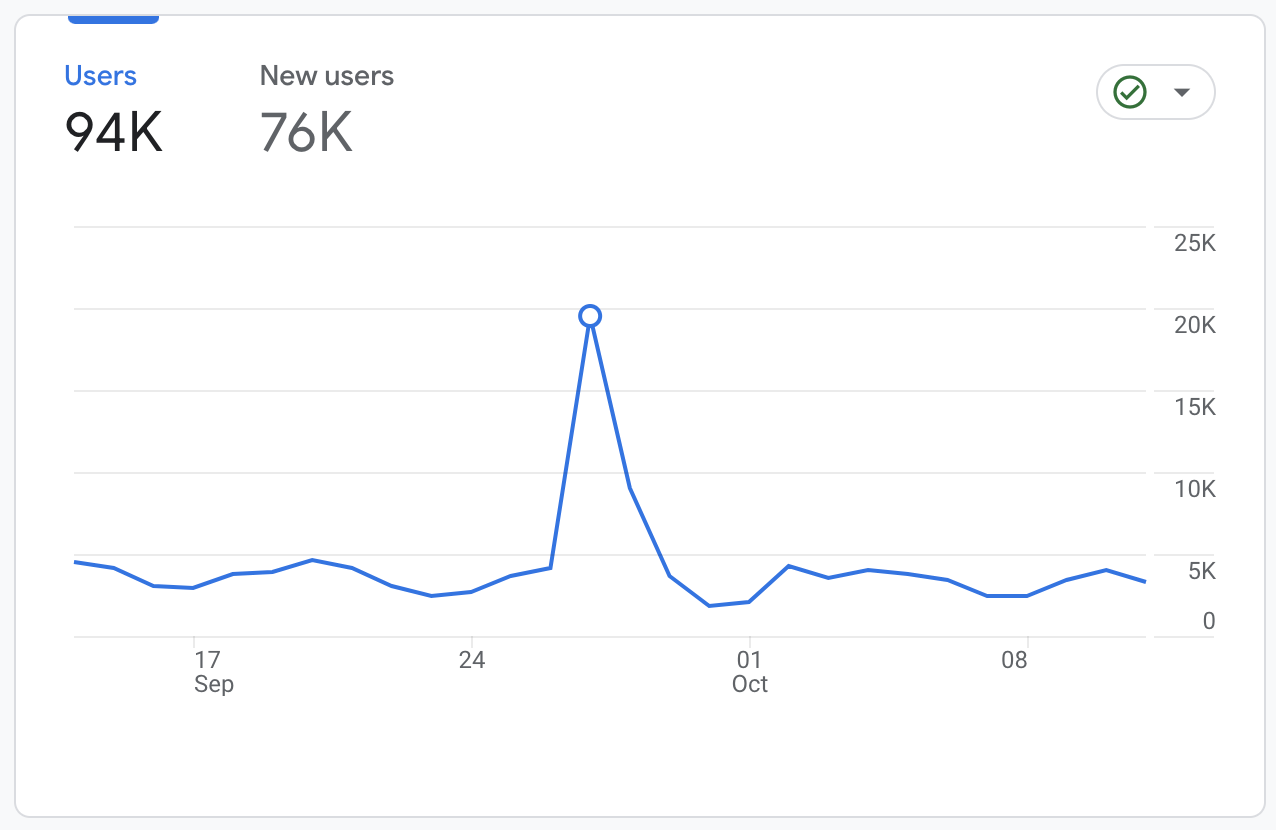
In UA, nonetheless, “Customers” had been the mixed variety of new and returning web site guests.
Engagement Price and Bounce Price
The best way you calculate engagement charge hasn’t modified in GA4: Engagement charge = Variety of engaged periods ÷ Whole variety of periods x 100
However the definition of “engaged session” has modified. In consequence, your engagement charge will differ from that of UA.
Let’s say you had 100 periods and 64 had been engaged periods. Your engagement charge in GA4 would now be 64%.
The brand new bounce charge is solely the inverse of the engagement charge in GA4. For instance, if engagement had been 64%, the bounce charge could be 36%.
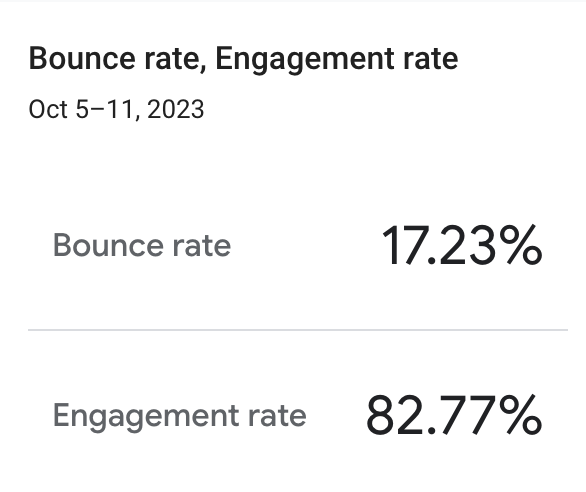
The bounce charge is the share of periods that weren’t engaged.
In UA, a consumer would set off a bounce by leaving after solely viewing a single web page. Even when the go to was longer than 10 seconds.
A excessive bounce charge can point out low-quality content material. However it may well additionally imply a consumer discovered what they got here for immediately. So the brand new bounce charge makes an attempt to simplify issues.
Common Engagement Time
Common engagement time in GA4 measures the typical time your web site or app is within the foreground of a consumer’s machine.
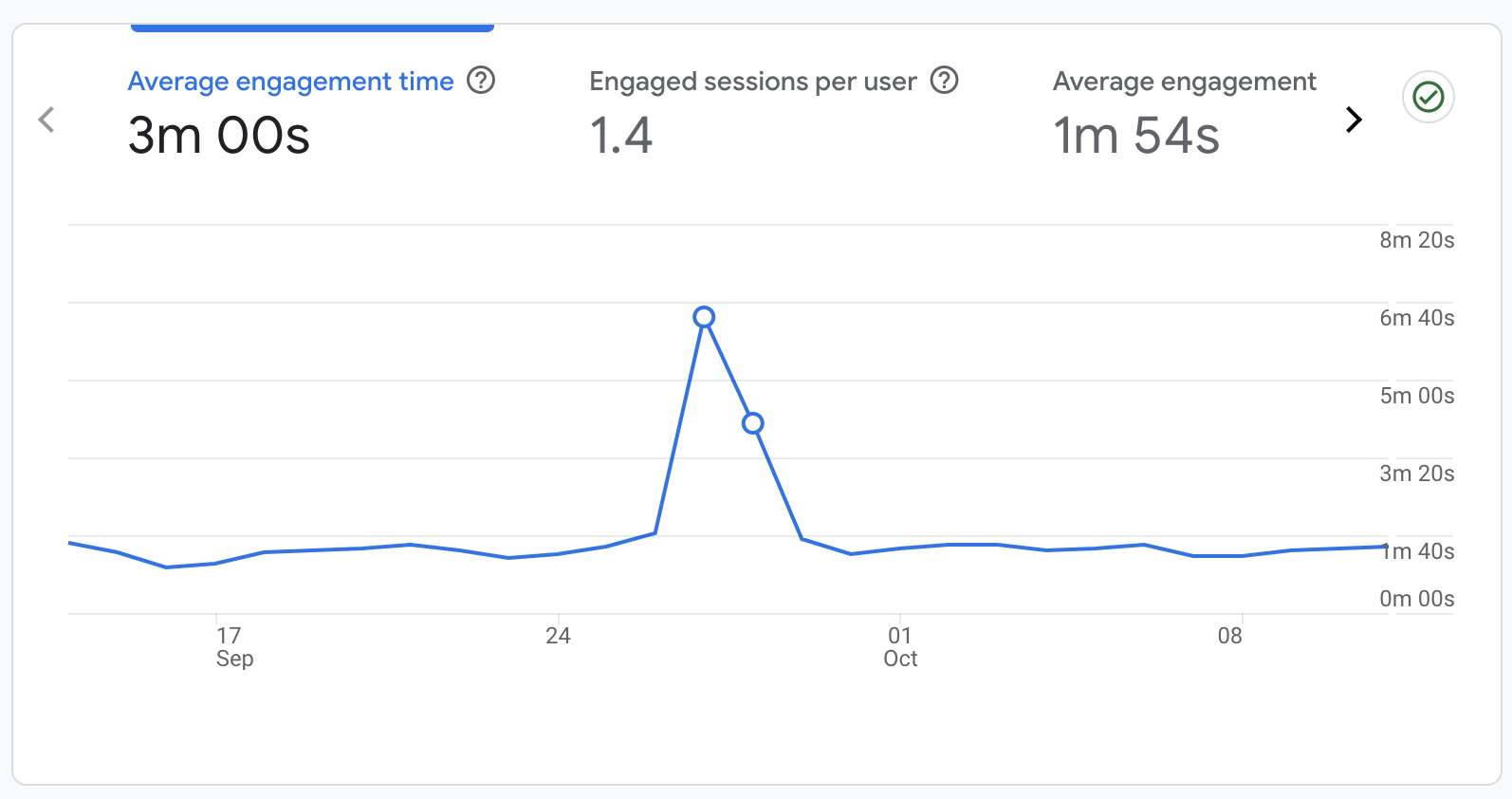
It’s the brand new and improved “common time on web site” metric. The outdated UA metric solely measured the size of time between periods.
The UA metric was typically inaccurate. That’s as a result of “common time on web site” wanted a primary and second session to be triggered. Bounced web site guests didn’t depend towards the whole as a result of UA counted them solely as one session.
Even when a consumer spent 10 minutes studying an article after which left.
Conversion Price
There are two kinds of conversion charges in GA4: session and consumer. They have to be added manually to your experiences.
Use the pencil icon to customise experiences and add both or each of those metrics:
- Session conversion charge: The share of transformed periods
- Consumer conversion charge: The share of transformed customers

You’ll be able to be taught extra about conversion charges on this information.
Join GA4 to Semrush to Optimize Your Advertising Analytics
GA4 is a strong instrument that may flip anybody into an information analyst. Nevertheless it isn’t essentially the most user-friendly.
In distinction, Semrush provides you full management of your advertising and marketing analytics information in easy, intuitive dashboards.
So try this record of GA4 and Semrush integrations to see the place you may sync them. And analyze your search engine marketing efforts from a central location.
[ad_2]
Supply hyperlink
About us and this blog
We are a digital marketing company with a focus on helping our customers achieve great results across several key areas.
Request a free quote
We offer professional SEO services that help websites increase their organic search score drastically in order to compete for the highest rankings even when it comes to highly competitive keywords.
Subscribe to our newsletter!
More from our blog
See all postsRecent Posts
- 301 vs. 302 Redirects: Which Ought to You Use? December 11, 2023
- 5 Tricks to Drive Enterprise December 11, 2023
- CEDEP Management & Security Tradition Programme L&SC 2.0 | Government Schooling December 11, 2023
